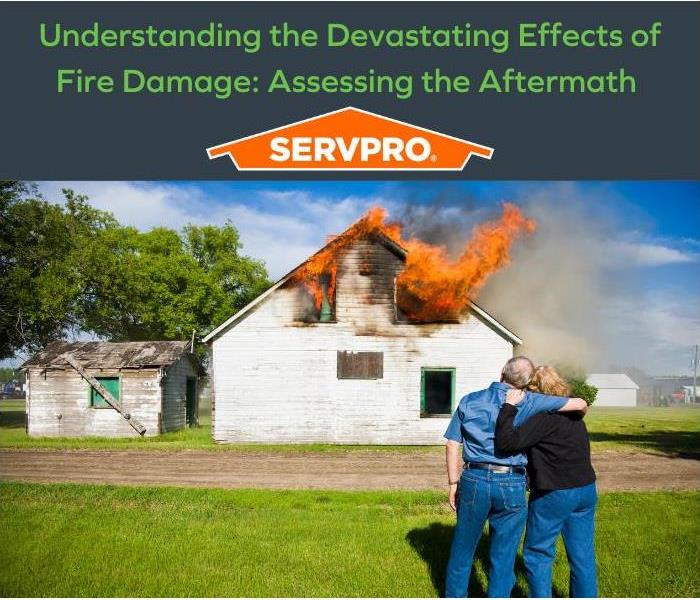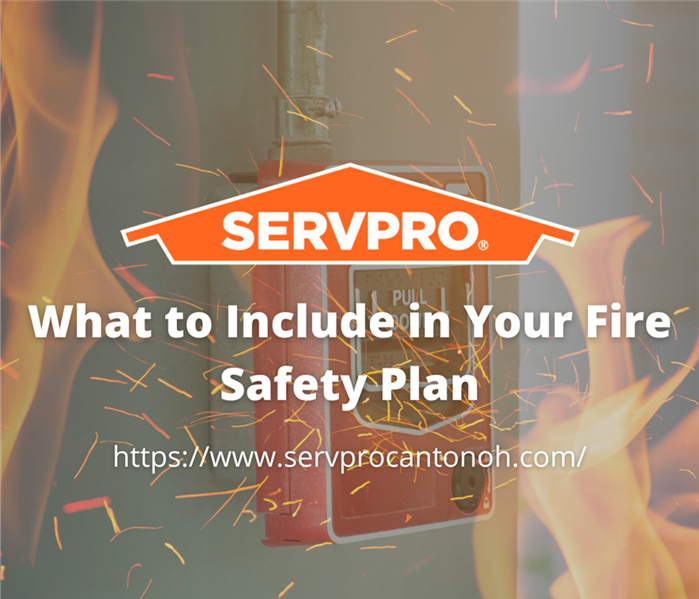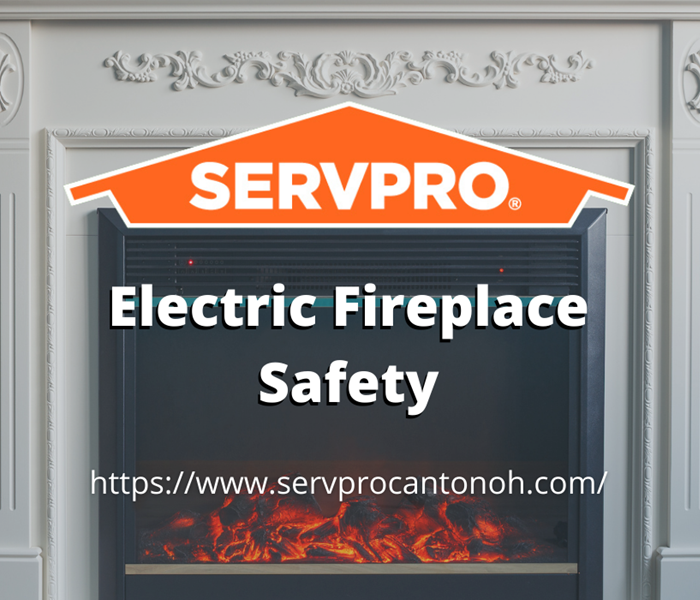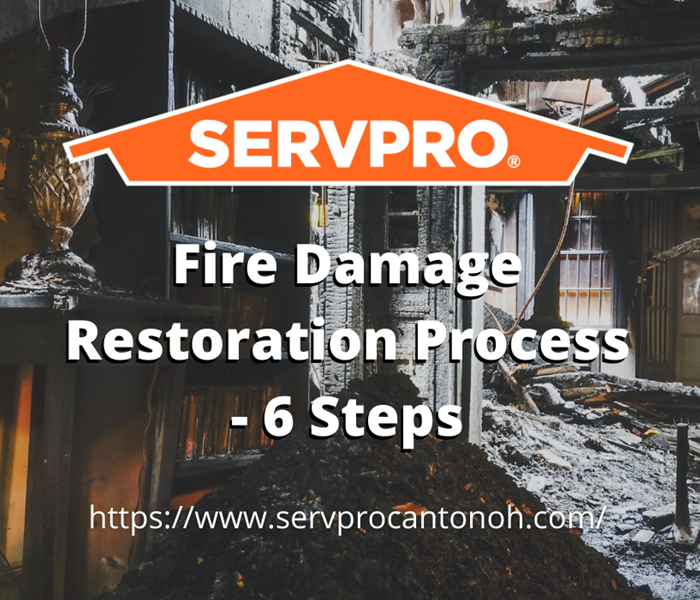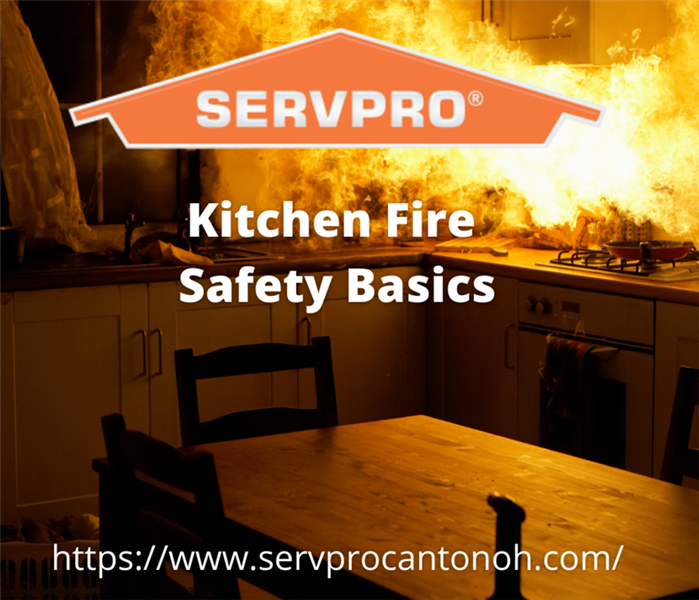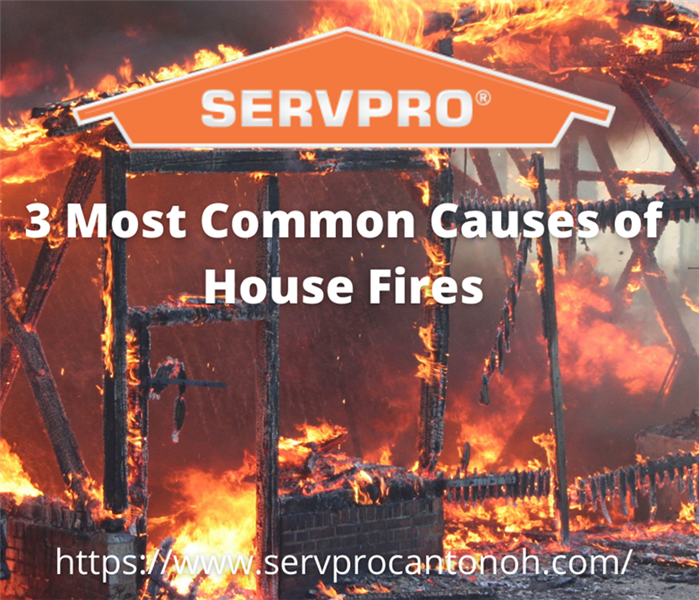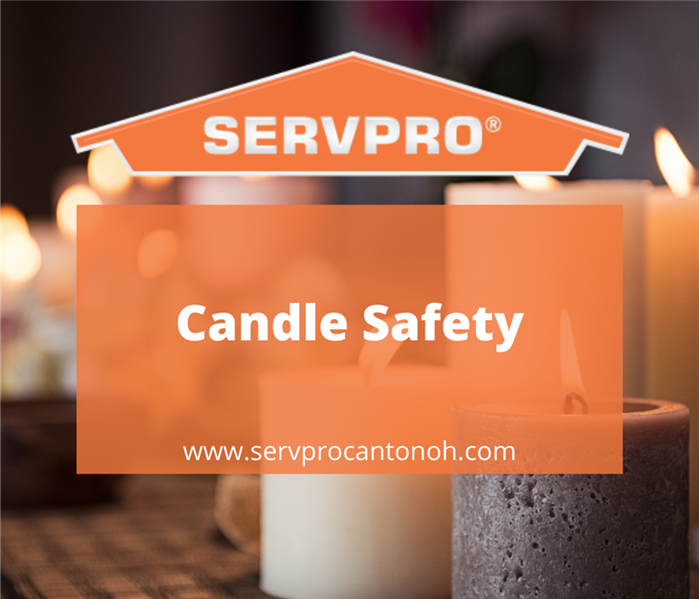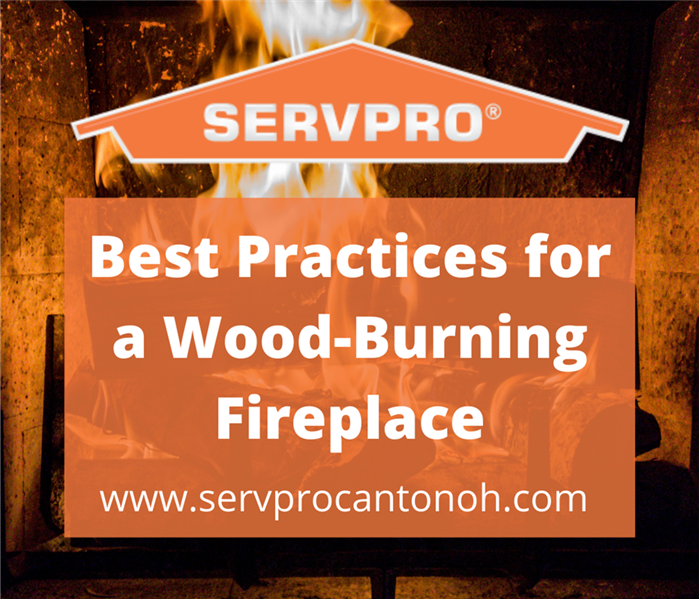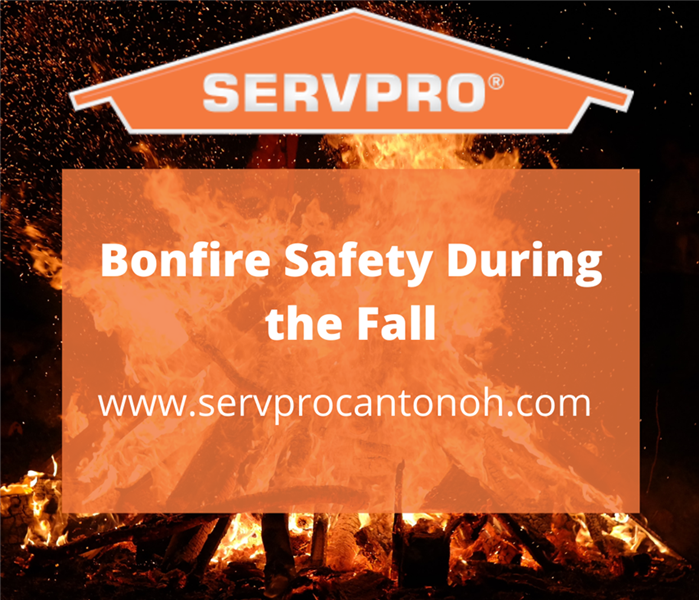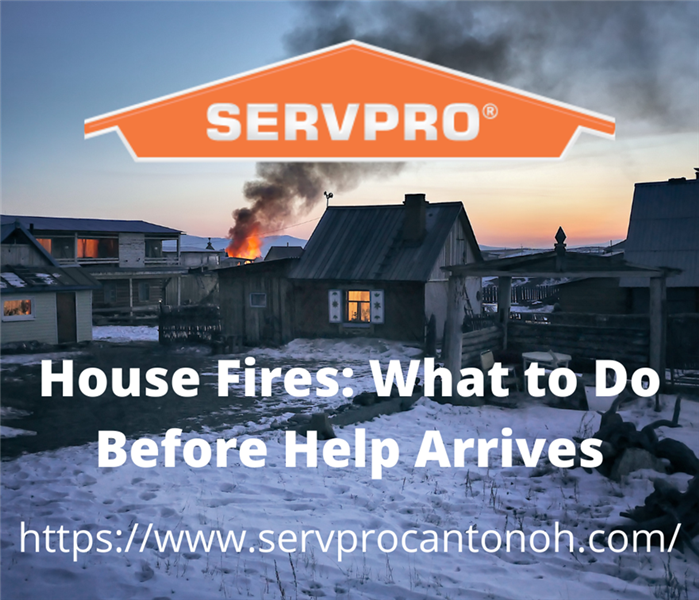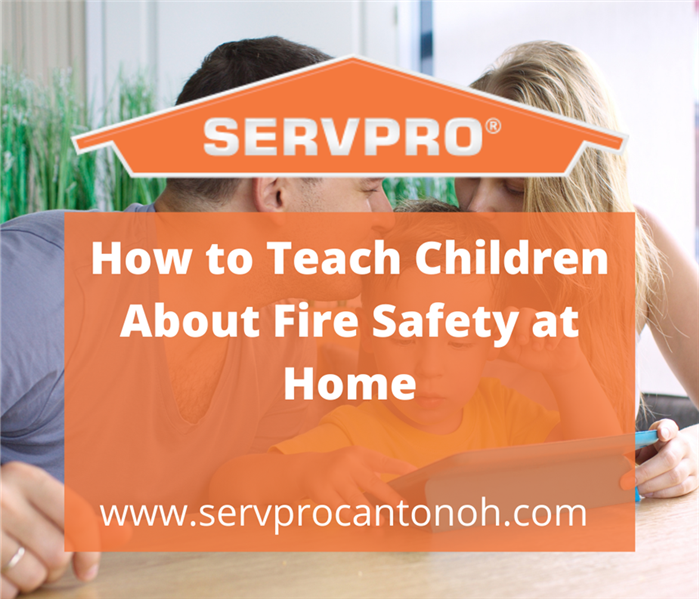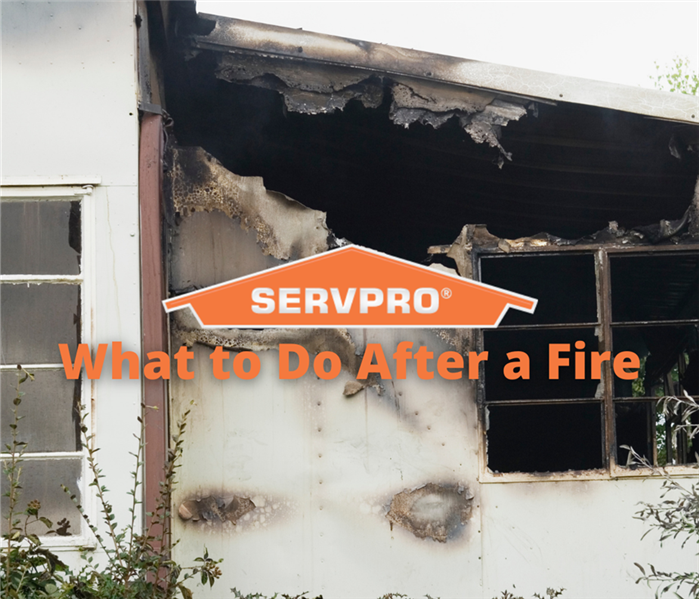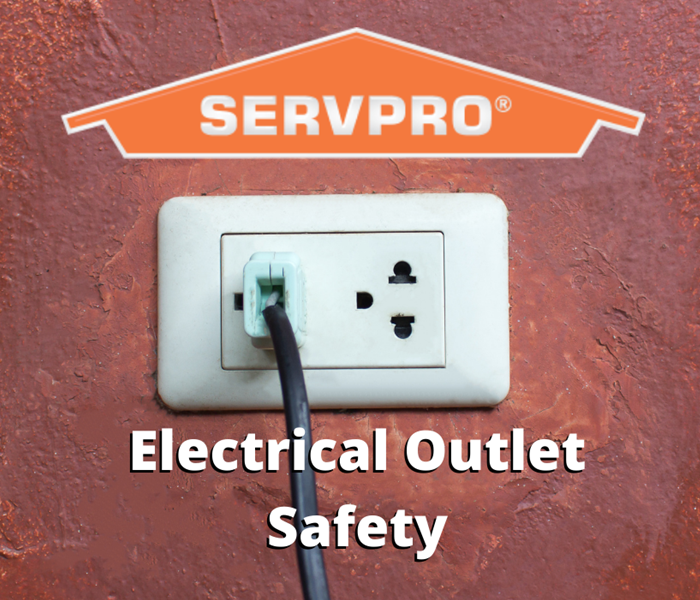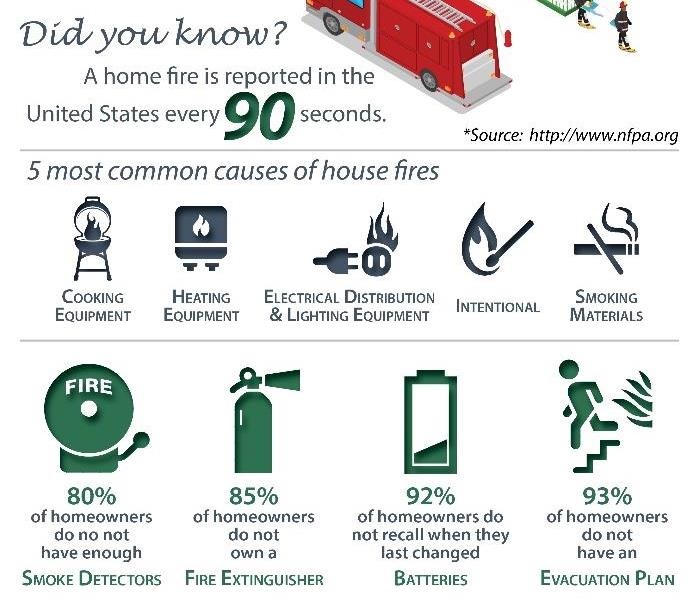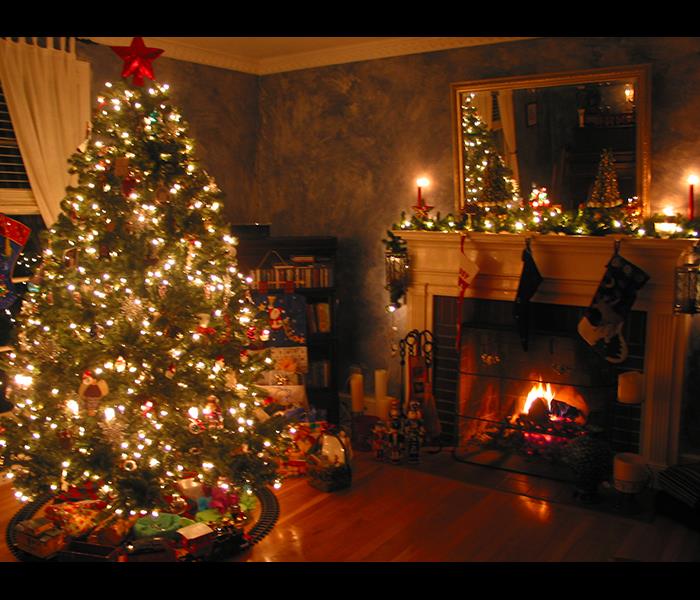Recent Fire Damage Posts
The Hidden Dangers of Smoke Damage
8/20/2024 (Permalink)
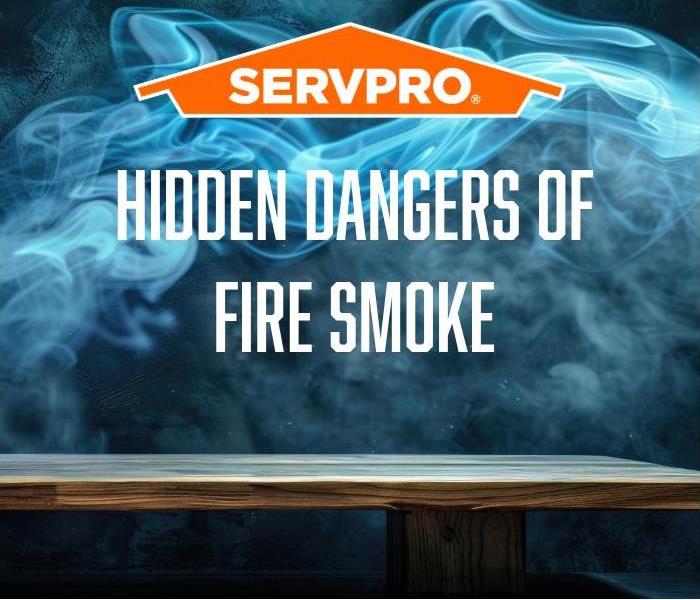 Smoke contains acidic compounds that can corrode metal, weaken wood, and discolor walls and ceilings, which can compromise the integrity of your home.
Smoke contains acidic compounds that can corrode metal, weaken wood, and discolor walls and ceilings, which can compromise the integrity of your home.
8/20/2024
While fire can consume parts of your home, smoke permeates every nook and cranny, often leaving behind invisible yet harmful residues. The extent of smoke damage depends on several factors, including the materials burned, the intensity of the fire, and the length of exposure. Regardless of the specifics, smoke damage can have long-lasting effects if not properly addressed.
Impact on Your Home
Smoke damage affects a home in several ways:
- Structural Damage: Smoke contains acidic compounds that can corrode metal, weaken wood, and discolor walls and ceilings. Over time, this can compromise the structural integrity of your home, leading to costly repairs if not promptly treated.
- Surface Staining: Soot, a byproduct of incomplete combustion, can settle on surfaces throughout your home. If left untreated, soot can cause permanent stains on walls, ceilings, carpets, and furniture. The longer the soot remains, the more difficult it becomes to remove, making professional cleaning essential.
- Lingering Odors: One of the most persistent effects of smoke damage is the odor it leaves behind. Smoke particles can embed themselves deep into fabrics, carpets, and even the air ducts of your home, causing unpleasant smells that are difficult to eliminate. Over-the-counter air fresheners and cleaning products often fail to fully remove these odors, making professional deodorization necessary.
- Electrical and Appliance Damage: Smoke can infiltrate electrical systems and appliances, causing short circuits and malfunctions. This not only poses a safety risk but can also lead to further damage if not properly inspected and cleaned.
Impact on Your Health
The effects of smoke damage extend beyond the physical damage to your home; they also pose significant health risks:
- Respiratory Issues: Smoke contains a mixture of harmful chemicals, including carbon monoxide, formaldehyde, and other toxic substances. Inhaling these particles can lead to respiratory problems, including coughing, shortness of breath, and aggravation of pre-existing conditions like asthma.
- Eye and Skin Irritation: The particles in smoke can irritate your eyes, causing redness, itching, and tearing. Prolonged exposure to smoke can also result in skin irritation, rashes, and allergic reactions.
- Long-Term Health Risks: Continuous exposure to smoke-damaged environments can lead to more severe health issues over time, including chronic respiratory conditions, cardiovascular problems, and an increased risk of cancer due to the carcinogenic compounds present in smoke.
The Importance of Professional Restoration Services
Given the extensive impact of smoke damage on both your home and health, professional restoration services are crucial in ensuring a thorough and effective cleanup. Here’s why:
- Comprehensive Assessment: Restoration professionals have the expertise and tools to accurately assess the extent of smoke damage. They can identify areas that may not be immediately visible but require attention to prevent further damage.
- Specialized Cleaning Techniques: Smoke damage requires specialized cleaning methods that go beyond standard household cleaning products. Professionals use advanced equipment and techniques, such as thermal fogging, ozone treatment, and HEPA filtration, to remove soot, odors, and contaminants from your home.
- Health and Safety Compliance: Professional restoration teams are trained to handle hazardous materials safely. They follow strict guidelines to ensure that the cleanup process is not only effective but also safe for you and your family.
- Prevention of Future Issues: By thoroughly addressing smoke damage, restoration professionals help prevent future problems, such as mold growth and structural deterioration, which can arise from improper or incomplete cleaning.
Conclusion
Smoke damage is a serious issue that can have lasting effects on both your home and your health. As August brings increased fire risks, understanding the importance of addressing smoke damage promptly and professionally is essential. By enlisting the help of restoration experts, you can ensure that your home is thoroughly cleaned and restored, safeguarding your property and well-being in the process.
Preparing for a Safe Labor Day Weekend: Fire Prevention Tips
8/20/2024 (Permalink)
 A dedicated firefighter stands tall, holding the American flag, a symbol of strength and service. This Labor Day, as we honor all their hard work!
A dedicated firefighter stands tall, holding the American flag, a symbol of strength and service. This Labor Day, as we honor all their hard work!
Labor Day weekend is a time for celebration, marking the unofficial end of summer with outdoor activities, barbecues, and family gatherings. However, while you're soaking up the last rays of summer, it's crucial to prioritize safety, particularly when it comes to preventing fires. Whether you’re grilling, enjoying a campfire, or setting off fireworks, following basic fire safety practices can make the difference between a memorable holiday and a disaster. SERVPRO Team Johnson is here to offer essential fire prevention tips to ensure that your Labor Day weekend remains both enjoyable and safe.
1. Grill Safety: Keep the Flames Under Control
Grilling is one of the most popular activities during Labor Day weekend, but it also comes with its own set of risks. To keep your barbecue from turning into a blaze, adhere to the following guidelines:
- Position Your Grill Properly: Place your grill at least 10 feet away from your home, deck railings, and overhanging branches. Ensure it's on a stable, flat surface to prevent tipping over.
- Inspect Your Grill Before Use: Check for gas leaks, cracks, or blockages in the hose and burner if you're using a gas grill. For charcoal grills, ensure that the grill is clean and free of old grease or ash.
- Never Leave Your Grill Unattended: Fires can ignite in seconds, especially when grease builds up. Always keep an eye on the grill while cooking and keep a fire extinguisher or a bucket of sand nearby to douse any flare-ups.
- Create a Safe Zone: Establish a "kid-free zone" of at least three feet around the grill. Pets should also be kept at a safe distance to avoid accidents.
2. Campfire and Fire Pit Safety: Enjoy Responsibly
- If you're planning to spend the evening around a campfire or fire pit, it's important to enjoy the experience safely. Here are some tips to keep in mind:
- Select the Right Location: Set up your campfire or fire pit at least 25 feet away from structures, trees, and flammable materials. Avoid areas with dry grass or overhanging branches.
- Prepare the Area: Clear the area around the fire of any debris, leaves, and twigs that could catch fire. Create a boundary with rocks or bricks to contain the fire.
- Start Small: Begin with small kindling and gradually add larger logs. Never use gasoline or other accelerants to start or revive a fire, as these can cause uncontrollable flames.
- Extinguish Completely: Before leaving the fire, ensure it is fully extinguished. Pour water over the fire, stir the ashes, and pour more water until everything is cool to the touch.
3. Safe Use of Fireworks: Light Up the Sky, Not the Yard
Fireworks are a traditional part of Labor Day celebrations, but they can be extremely dangerous if not handled correctly. Here’s how to enjoy fireworks safely:
- Follow Local Laws: Always adhere to local regulations regarding fireworks. In some areas, fireworks may be banned due to fire risks.
- Keep a Safe Distance: Light fireworks away from people, houses, and flammable materials. Never point or throw fireworks at another person.
- Have Water Ready: Keep a bucket of water or a garden hose nearby in case of a fire. After the fireworks have finished burning, douse them with water before discarding them to prevent a trash fire.
4. Charcoal Disposal: Don’t Let Hidden Dangers Linger
If you're using a charcoal grill, be mindful of how you dispose of the coals. Improper disposal can lead to fires even after the cooking is done.
- Let Coals Cool Completely: Allow the coals to cool completely, which can take several hours or even overnight.
- Use a Metal Container: Place the cooled coals in a metal container with a tight-fitting lid. Never use a plastic or paper bag, as these materials can catch fire.
5. Stay Sober Around Flames
Alcohol is often part of holiday celebrations, but it can impair judgment and reaction times, increasing the risk of fire-related accidents. Ensure that there’s always someone who is sober to monitor the grill, campfire, or fireworks.
6. Emergency Preparedness: Be Ready to React
Despite all precautions, accidents can still happen. It’s essential to be prepared:
- Know Emergency Contacts: Have emergency contact numbers, including the local fire department, readily available.
- First Aid Kit: Keep a first aid kit accessible in case of minor burns or injuries.
The Hidden Dangers of Front-Mounted Stove Burner Knobs
8/8/2024 (Permalink)
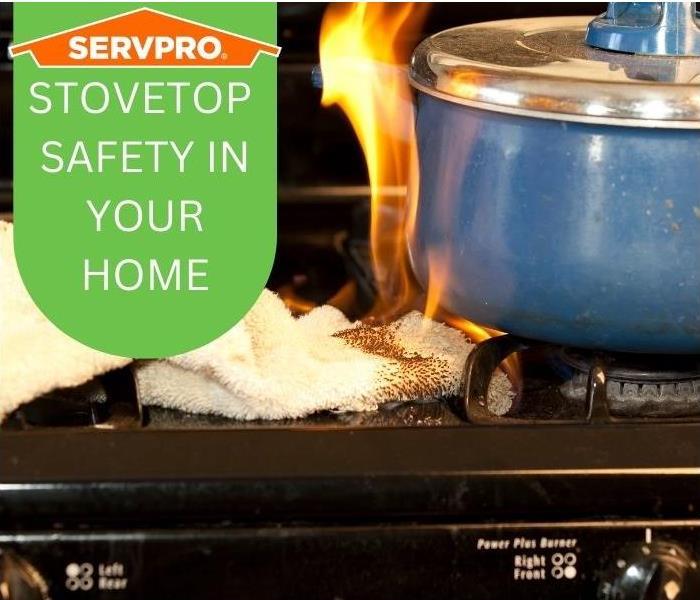 Minor mishaps can turn into a major cleaning project. Let the professionals handle this cleaning job!
Minor mishaps can turn into a major cleaning project. Let the professionals handle this cleaning job!
The kitchen is often the heart of the home, a place where families gather to cook, share meals, and create memories. However, it's also a space that can pose serious safety risks, especially when it comes to stove design. One often overlooked hazard is the placement of burner knobs on the front of the stove. While this design may seem convenient, it can actually be a significant safety risk, particularly for households with young children and pets.
The Risk of Accidental Activation
Stoves with front-mounted knobs are particularly vulnerable to accidental activation. Curious toddlers or playful pets can easily reach the knobs, turning them on without anyone noticing. A simple nudge or bump can ignite a burner, potentially leading to a dangerous situation. This is a particular concern in homes where the stove is used as a temporary storage space. It's not uncommon for people to place items on the stove when they run out of counter space or simply for convenience. However, this habit can quickly turn dangerous if a knob is accidentally turned, igniting flammable materials.
The Danger of Kitchen Fires
Once a burner is unintentionally activated, the risk of a kitchen fire increases dramatically. Items like paper towels, plastic containers, grocery bags, and other everyday objects can catch fire within seconds. The consequences can be devastating, leading not only to property damage but also to potential injury or even loss of life.
The Role of Pets and Children
Pets and young children are naturally curious. A cat might jump onto the stove to explore, or a dog might brush against the knobs while sniffing around for food. Similarly, children might see the knobs as something fun to turn or play with, unaware of the danger they pose. Even if the burners aren't activated, gas stoves can release harmful gases if the knobs are turned slightly, creating an additional layer of risk.
Preventive Measures
To mitigate these risks, consider the following safety measures:
- Use Stove Knob Covers: These simple, affordable devices can prevent accidental activation by covering the knobs. They are easy for adults to remove but difficult for children and pets to manipulate.
- Stove Guard or Barrier: A physical barrier can keep both pets and children away from the stove. This can be especially useful during cooking, when distractions can lead to accidents.
- Child and Pet Safety Education: Educate older children about the dangers of playing with stove knobs. For pets, training them to stay off kitchen counters and away from the stove can be effective.
- Alternative Storage Solutions: Avoid using the stove as a storage space, especially for flammable items. Find other areas in your kitchen for temporary storage to reduce the risk of fire.
- Install Safety Sensors: Some modern stoves come equipped with safety features like automatic shut-off sensors. If upgrading your stove is an option, consider one with these built-in safety features.
While front-mounted stove knobs offer convenience, they also present a significant safety hazard, especially in households with pets and young children. By taking proactive steps to secure your stove and educate your family, you can greatly reduce the risk of accidental activation and the potential for dangerous kitchen fires. Safety should always be a priority, and with a few simple precautions, you can help ensure that your kitchen remains a safe and welcoming space for everyone.
Minor mishaps can turn into a major cleaning project. Let the professionals handle this cleaning job! Join the many satisfied customers who trust SERVPRO of Canton to restore their homes and peace of mind. Call us today to learn how we can help you keep your home safe. 330-966-2377
Understanding the Devastating Effects of Fire Damage: Assessing the Aftermath
8/1/2023 (Permalink)
Fire has the potential to destroy your property, burning appliances and devastating effects. Fires don’t just cause one type of damage, there is not only damage done by fire, but by heat, smoke, and water. But besides physical damage, there is the emotional distress that comes with it. You lose your residence, your place of security, safety, and comfort. Relocating and rebuilding can be emotionally exhausting, many often experience bitterness, disbelief, and sadness, before coming to a stage of acceptance, and begin moving forward.
Before reaching a stage of acceptance it is important to take care of yourself, and practice self-care. It’s important to remember to keep a routine, maintain a normal sleep cycle, and use the community support available. SERVPRO is here to help you navigate the confusing time after a fire, helping ease the burden.
What to Include in Your Fire Safety Plan
7/26/2022 (Permalink)
- Create a plan for each room
Your fire emergency plan will be different for each room of your home because the exit points are different. Some rooms are on the first floor while some are on the second or third which requires completely different escape routes.
- Have two ways out of each room
It is important that your plan involves two different exits out of the same room. Most people do one exit plan through the door and one exit plan through the window. This is in case one exit is blocked by flames.
- Have yearly family meetings about evacuation plans and practice
Each year, your family should familiarize themselves again with their fire escape plan. Some exit routes may change as the house and landscaping are updated. If your master bedroom's window exit relied on the tree in your front yard that was cut down, you will have to create a new plan for that room.
- Choose a meeting spot after evacuations
Included in your fire escape plan should be a meeting spot for the whole family once everyone escapes from their respective rooms. This can be a local park or just your neighbor's house, but this should be set in advance so you can quickly figure out who may be stuck in the house.
Electric Fireplace Safety
2/2/2022 (Permalink)
Now that winter is in full swing, we are all looking for ways to warm up. Electric fireplaces are one of the many ways you can keep your house toasty. Unlike a traditional fireplace, they do not use wood. Instead, it only relies on electricity. Just like any other appliance, it is important to look into safety tips before you begin using your fireplace regularly.
Since electric fireplaces don't burn wood, they are a much safer alternative to a wood-burning fireplace in your home. It is not always ideal to have a fire in your house, so opting for the warmth and coziest of electric fireplaces is the best option.
Leave the Heater Off
Leaving the heater off can limit the chance of an electrical fire. Although the risk of an electric fireplace is unlikely, if you do not need the heat on, don’t use it. You can still have the ambiance of the fireplace, just a little bit safer.
Don’t Block the Heater Inlet or Outlet
By blocking the fireplace’s inlet or outlet, you may be risking the fireplace overheating. Limiting the risk of your appliance overheating is key to using an electric fireplace safely.
Prioritize Quality
The higher quality fireplace you invest in, generally, the safer the appliance will be. We suggest reading reviews and researching products in your price range.
Electric fireplace safety may seem simple, but it is still important to review. If there is ever a disaster and you need help, call SERVPRO to help. Electric fireplaces are becoming safer and safer, but it is still essential to prioritize the safety of you and your loved ones.
Fire Damage Restoration Process - 6 Steps
2/2/2022 (Permalink)
No one ever wants to have to deal with restoring their home after a fire wreaks havoc on their family. But that is why your local SERVPRO is here; to deal with the stress so you can get back to normal as soon as possible. Although we will be there to help all along the way, there are a few crucial steps you should be prepared to take if and when disaster strikes:
- Get in touch with an insurance agent immediately
It is important to know what your insurance will cover, if anything, right at the beginning of the incident. Financial stress can be one of the worst parts of the process, but ensuring you are covered can prevent any unnecessary strain.
- Find a copy of the fire damage report
These public documents are critical to have because they contain all of the necessary information about the incident. Keeping these documents in a personal file for later use will likely benefit you if there are any discrepancies.
- Start the mitigation process
This is where we come in. Call your local SERVPRO so we can be faster to your disaster. Our teams move quickly and carefully to ensure the proper restoration and protection of your home and valuables. This is not a process you should try to take on alone.
- Keep a record of all damaged items
Keeping a record of all of the things that were damaged can help with contents coverage when it comes to insurance. Your insurance company will likely cover the costs of any and all replacements after the fire.
- Clean up
Another job for us at SERVPRO. We pride ourselves on the most thorough and professional restoration and cleaning services. Get it done right the first time, so you don’t have to go through the process of finding a replacement service for lackluster restorative and cleaning processes.
- Start the Recovery process
Rebuilding and restoring a fire-damaged home can be a tough situation in all directions. Make sure you continue to document all of the repair and replacement spendings you make throughout the journey to better assist with the cost.
SERVPRO goes above and beyond in our fire damage restoration process. Should an unfortunate incident ever befall you, know you can trust in us to get it fixed right, the first time.
Kitchen Fire Safety Basics
1/27/2022 (Permalink)
Home is where the heart is, and they say the kitchen is the heart of the home. This is rightly so, the magic of home-cooked meals and family bonding through cooking together; it doesn’t get much heartier than that. While the kitchen is a great place for family, fun, and food, there are also many hidden dangers lying all around. In fact, the great majority of house fires start in the kitchen.
Learning the basics of cooking and preparing food safely in the kitchen is a must for the safety of you, your home, and your family.
Never Leave a Heat Source Unattended
This one is a no-brainer. Leaving the stove or oven unattended for even a second can leave room open for a fire disaster to break out in your home. Be mindful of your attention span when cooking. If you are under the influence or feeling sleepy, it’s probably not a good idea to be operating cooking equipment.
Be Alert
Always be aware of your surroundings and be prepared to control any fires or stray sparks that may flare-up. Do not let children or pets near the cooking area to prevent any distractions or further hazards.
Be Tidy
Put any food scraps in the garbage or away from the cooking surface. This will prevent potential fire hazards. Pay attention to grease spills or flammable materials.
Use a Timer
Your internal clock may be accurate, but don’t leave anything up to chance. Fire’s wait for no man!
Dress to Cook
Leave the loose, baggy clothing in the closet. Make sure nothing is dangling from your arms that could end up catching a flame.
And there you have it! A crash course on kitchen safety from your #1 restoration service, SERVPRO.
3 Most Common Causes of House Fires in America
1/25/2022 (Permalink)
It’s every homeowner’s worst nightmare. You hear the piercing chirp of the smoke alarm. You smell burning and then smoke. And you realize your home is on fire. Luckily, there are some precautions you can take to prevent becoming the victim of the three most common causes of American house fires.
The most common cause of house fires is unattended cooking. Whether you’re baking, grilling, broiling, or boiling, never leave your cook station unattended. We’re all human, and, therefore, forgetful. We walk away from the stove to do one thing, and then we get a text, and 20 minutes later we smell burning. It’s a terrible feeling!
When cooking, never leave the stove or grill unattended. If you absolutely must step away, set an alarm on the stove. That way, if you forget, the stove alarm will remind you. Also, be prepared, and have a fire extinguisher on hand. Every floor of your home should have a working fire extinguisher. Pay attention to the “service by” date, and have your extinguisher serviced regularly.
The second most common cause of house fires is due to improper use of heating equipment like space heaters. When using a space heater, make sure it is set away from any flammable material like clothes, bedding, curtains, furniture, and carpet. And remember, space heaters should only be used to heat small areas of your home, not the entire home. So use them accordingly, and do not leave them on when you leave home.
The third most common cause is scary because it’s so difficult to detect: faulty wiring. Behind your walls, you could have old wiring that could cause sparks and lead to fires. But there are some signs you can look out for. If you notice that when you use other appliances your lights flicker? Do you often experience blown fuses? Do you smell burning or melting plastic around your outlets? Any of these signs could mean you have faulty wiring. If you suspect your home may have faulty wiring, contact your trusted electrician to investigate.
Candle Safety
1/4/2022 (Permalink)
Trim the Wick
When you burn a candle, trim the wick every time. Be sure to cut it between ? and ¼ inches long. Items such as scissors, nail clippers, or if a wick trimmer to be extra careful. When you trim your wick, you will have a bright, clean burn. If your wick is untrimmed, your flame will be misshapen and it will obscure the flame.
Melt Wax All the Way Across.
When you light your candle, make sure that the top layer of wax is melted across the candle. This process typically takes some time so make sure that you have time to let your candle burn.
Burn for Four Hours at a Time
If you burn your candle for more than four hours, it can collect carbon on the wick. This can cause your wick to become unstable. Burning your candle for too long can also create a flame that is too large for the candle.
Multi-wick Candles
Try out a multi-wick candle for a more fluid, level burn. Having multiple wicks to your candle can lead to a proper burn for your candle, a quicker burn, and a stronger scent.
Keep Candle Away from Wind
Try not to burn your candle close to windows, fans, or air conditioning. Lighting your candle by an area with moving air could disturb the flame. It can also stain a jar if it is made out of a tin.
Dip the Wick of Candle
When you are ready to extinguish the flame, do not blow out the candle. Blowing out a candle causes the wick to continue to burn even though the flame has been let out.
Be safe when lighting your candles, and always remember to extinguish the flame when you are done using them. Most importantly, keep them out of the reach of young children and away from flammable objects.
Best Practices for a Wood-Burning Fireplace
1/4/2022 (Permalink)
When cold weather comes more people use their fireplaces. Many people have gas fireplaces as well as wood. Safety precautions need to be taken with both practices, however, we have some advice as to the best practices with a wood fireplace.
Keep it Clean
It is important to maintain a clean fireplace before burning anything in it. This is because if there is debris within the fireplace, it can be dangerous and burn down your home. To clean it up, you can do multiple things like vacuuming up the ash and removing all of the buildups. If this task is not something you’re comfortable with, you can always hire a chimney sweep to inspect and clean your chimney/fireplace. It is recommended to have them come at least once a year to better guarantee your safety. When cleaning your fireplace on your own, make sure to wear protective gear like gloves, goggles, and masks to protect your body from any debris or harm. Maintaining a clean fireplace is a key step to take before burning any wood.
Type of Wood
The type and quality of wood will affect the way it burns. It is recommended to burn hardwoods like oak, birch, etc., as opposed to softwoods like cedar, pine, etc. This is because hardwood will burn for a longer period of time as opposed to softwoods. Softwood may also have more sap within the wood which can cause more sparks as well as smoke. If there is a lot of smoke regularly with your fireplace, however, take that as a warning sign that there may be problems with it.
Take action and be cautious with your fireplace and don’t hesitate to call a professional. Here at SERVPRO, we are here to help you with maintaining your home safety. Contact us today at 1-800-SERVPRO for more information.
Are Electric Blankets Safe?
12/27/2021 (Permalink)
In the ’80s and ’90s, electric blanket fires were known to cause house fires. After the rise of house fires from electric blankets, the general public grew unsure of their safety. The fires would start from the wires in the blankets overheating. Another reason that there were fires from electric blankets is due to them not being stored correctly. If an electric blanket is left plugged in for too long, that also presents a fire hazard, especially if it is near other flammable objects.
The majority of problems that come with are not the product itself, but the way they were being used. You should not use an electric blanket that is more than 10 years old. Electric blankets that are available now are much smarter and advanced, and overall much safer to use.
Many modern electric blankets have a feature that allows them to automatically shut off after an extended period, making them very safe to use. This can prevent the product from overheating or reaching a very high temperature. If you still have reservations about using an electric blanket, use it away from flammable objects and do not leave it plugged in for too long.
Here are some quick tips for using your electric blanket safely:
- After every use, unplug your electric blanket.
- Avoid crumpling or bunching your blanket when storing it.
- Wash your blanket according to the manufacturer's instructions.
- If you use it every night, leave it unplugged and keep it in a cool dry place.
- Do not keep your blanket for more than 5-10 years, no matter how high quality it is.
Before you buy an electric blanket, make sure to research the brand and make sure that it is of high quality. Make sure to use your electric blanket safely. If you have further questions about your electric blanket, contact the manufacturer.
Bonfire Safety During Fall
11/1/2021 (Permalink)
Bonfires during the fall season can be so fun and a great way to bond with your friends and family. Sitting by the campfire can make for a time to tell scary stories, play games, share secrets, and create fun memories. Smelling the campfire and roasting marshmallows makes for great fun and a new adventure. While hanging out by a campfire is a fun activity, it can be easy to forget about the risk factors associated with having a bonfire.
Bonfire Safety tips:
Make sure to check the weather if you are planning to have a bonfire, if it is overly windy, you may want to reschedule for a clear day. Wind can make it hard to light the fire and it could also blow sparks around the surrounding bushes or trees. In addition, always check the direction of the wind before you start the fire. If you have a portable fire pit, you could move it to an area where there is a windbreak.
Store your firewood in a safe place. If you want to keep your fire pit going for a long time, you will have to keep feeding it firewood. Make sure that it is stored in a safe place away from the fire pit. Feed the fire pit at your place.
Build your fire out in the open, to ensure no chance of surrounding areas catching fire. You should never light a fire underneath a building or beneath trees. Make sure to keep the immediate area around the fire pit clear of any flammable objects as well.
Never leave your fire unattended. Even if a fire has weakened significantly or died down, it is still a hazard to leave it unattended. Even if you are going in for a quick bathroom break or to grab a drink, do not leave the fire alone under any circumstances. While small flames may appear to be harmless, they are still considered a threat to safety when left alone. Pour water over live embers, and make sure that all logs have fully stopped burning before you stop lighting them.
Keep chairs far away from the fire. Of course, most know to be careful around a fire, but sometimes when wanting to bundle up or make a s'more, a person can be closer than recommended. When you sit too close to a bonfire, the flames can touch your clothing, hair, or other flammable materials. Make sure that your sleeves are rolled up and your hair is tied back when you are tending to the fire, especially when roasting marshmallows or other foods.
Drink responsibly around a fire. While alcohol is flammable, overindulgence is also never a good idea, especially by fire. If you or your guests are planning to drink by a fire, do so in moderation and make sure that your judgment is never impaired.
Having a bonfire is so fun and a great way to make some fun fall memories. Make sure to follow these tips to stay safe during your bonfire, and have fun!
Fire at Home: What to Do before Help Arrives
11/1/2021 (Permalink)
When a fire breaks out at home, it can be easy to revert to a state of panic. However, it is integral that you remain calm and think with a clear head. House fires are responsible for over 2,600 deaths each year, but prevention is actually quite simple if you have the knowledge. Your local SERVPRO is here to help with some valuable tips on just how you should take action in the event of a house fire.
If Possible, Extinguish the Fire
Firstly, inspect the situation to see if this is a manageable fire. If you can extinguish the fire yourself, ensure you do so quickly and thoroughly to prevent further spreading and damage to your home. Remember PASS: pull the pin, aim at the base of the fire, squeeze the handle, and sweep from side to side.
Ensure a Safe Escape
In the case that a fire is not manageable, immediately run to safety and call for help. If there is smoke in the home, make sure you stay low to the ground and try to avoid doors that feel hot on the other side.
Get to Safety
As soon as you get outside, get a safe distance from the fire to ensure you remain unaffected should the fire spread to the perimeter of the house.
Call for Help
Once you have made it to safety, CALL FOR HELP. If you don’t have your hands on a phone, get to a neighbors house to access communication as soon as possible. When you reach 911, give them all the information they need, and do not hang up until you are certain to help is on the way.
If You Get Trapped Inside
Don’t panic. Make sure you cover all cracks around the doors with any material you can find, wet if possible. If you have access to a phone, dial 911. When stuck in the upper stories of the house, hang something out the window to alert help of where you are. Do not attempt to escape if you are in a safe room. Should you catch fire, remember: Stop, Drop, and Roll. Be sure you are continually covering your face.
SERVPRO is here to help with the aftermath, but our most important priority is that you stay safe, know how to prevent these fires from potentially spreading, and know the proper procedures.
How to Teach Children About Fire Safety at Home
9/6/2021 (Permalink)
A parent’s biggest goal is to make sure that their child is always safe. We live in a world where there are many things to be fearful of, but the best thing that you can do is teach your child what to do in a dangerous situation.
One of the disasters we tend to teach children about earliest is fire. The key to introducing fire safety is to have a plan to teach your children if there is a fire at your home.
Make sure your fire alarms are working properly.
Primarily, you need to make sure your fire alarms are functioning properly so you can introduce what a fire alarm is and how it works to your children.
Fire alarms are there to alert you that there is a fire, so in case there is actually a fire in your home you need to make sure your child knows what that sound is.
Plan your escape route.
You need to have a plan on how you and your children are going to get out of your home in the case of a fire. They need to be able to get out from their bedroom, so a window may be the easiest way for them to get out. You might need to get a rope ladder to assist them to get out of the house safely.
Decide on a family meeting point.
Once you make it out of the house, you need a safe place to be until help arrives. The point should not be too close to your own home. Some good places to consider are across the street, a neighbor a few doors down, or even walk to a neighboring road. Make sure that your child is comfortable with the location you choose as a safety point.
Put your plan into practice.
The key to having a safe and successful plan for fire safety is to make sure you practice it. This allows you and your family to become comfortable with what to do in the event of a fire. It is best to be over-prepared than under-prepared.
Fire safety is going to be something that your child has most likely never thought of, so it may be scary to them at first. The goal of teaching your child about safety is to make sure that your child is comfortable with knowing what to do in a dangerous situation.
SERVPRO is always happy to help with disaster prevention, so do not hesitate to contact us to help make your home a safer place.
What to Do After a Fire
7/8/2021 (Permalink)
After the fire trucks leave, your home likely suffers from fire and smoke damage and extensive water damage from firefighting efforts. SERVPRO Franchise Professionals have the specialized fire restoration training needed to restore your home to pre-fire condition.
Have Questions About Fire, Smoke, or Soot Damage?
Call Today 1-800-SERVPRO
Every fire damage event is a little different, and requires a unique solution, but the general process stays the same. The steps listed below illustrate our process for the “typical” fire damage emergency.
Step 1: Emergency Contact
The restoration process begins when you call the SERVPRO Customer Care Center, which is staffed 24 hours a day. Our specialist will ask a series of questions regarding the fire damage event that will help us dispatch the nearest SERVPRO Franchise Professional with the appropriate equipment and resources.
Step 2: Inspection and Fire Damage Assessment
Our Professionals will carefully inspect and test adjoining rooms of your property to determine the extent of the fire, smoke, and soot damage. This step is crucial to developing a plan of action.
Step 3: Immediate Board-Up and Roof-Tarp Service
Fire damage can often compromise windows, walls, and roofs. To maintain security and to protect against further damage, the SERVPRO Franchise Professional can board up missing windows and walls and place tarps on damaged roofs.
Step 4: Water Removal and Drying (if water damage is present)
The water removal process begins almost immediately and removes the majority of the water. They will then use dehumidifiers and air movers to remove the remaining water and complete the drying process.
Step 5: Removal of Smoke and Soot from All Surfaces
The SERVPRO Franchise Professionals use specialized equipment and techniques to remove smoke and soot from ceilings, walls, and other surfaces.
Step 6: Cleaning and Sanitizing
They will clean all of the restorable items and structures that were damaged by the fire. They use a variety of cleaning techniques to restore your belongings to pre-fire condition. They’re also trained to remove odors using industrial air scrubbers and fogging equipment.
Step 7: Restoration
Restoration is the final step—getting your home or business to its pre-fire condition. Restoration may involve minor repairs, such as replacing drywall, painting, and installing new carpet; or it may entail major repairs such as the reconstruction of various areas or rooms in a home or business.
Electrical Outlets & Home Fires - What to Look For
2/26/2021 (Permalink)
Need to charge your phone, plug in your hairdryer or mixer? Electrical outlet. Need to start a fire? Not an electrical outlet. Outlets are one of the top causes of electrical fires. Home electrical fires account for over five thousand fires a year, resulting in billions of dollars in property damage, injury, and death. The U.S. Consumer Product Safety Commission reports that over a fifth of home electrical fires are caused by outlets. Electrical fires are scary, but how do you avoid them? What should you even look for?
Overloaded outlets not only look bad but are dangerous. When an outlet is overloaded, it carries too much electricity and will generate lots of heat. The heat will create wear on the internal wiring system and can start a fire. Avoid plugging in more than two appliances in an outlet, and I know what you are thinking, “what if I just plug in an extension cord? Then can I plug in more appliances?” Nope, that is called ‘piggybacking,’ and it’s not safer and can produce even more heat, making it exponentially riskier. One should only temporarily use extension cords and NEVER use a space heater or an air conditioner on an extension cord. If you really need more outlets somewhere, consult a qualified electrician.
Outdated outlets can also create issues. As the wires behind the outlet become older, they could loosen or break, causing a fire. The wiring system behind outlets will have a fuse or circuit breakers that will disconnect when the outlet is overloaded. However, an improperly installed fuse or circuit breaker could eliminate this safety focus. Ask an electrician to inspect your house to ensure that it meets safety standards.
Not only the wiring for the outlet wear, but the blades within the outlet can as well. This will be present if, after plugging an appliance in, the cord will fall out. Perhaps, this happening may seem just annoying, but it can be dangerous. The loosened blades will generate heat, potentially causing an electrical fire. If you notice this, your best bet is to replace the outlet as soon as you can.
Home electrical fires with the cause being outlets is an easily preventable worry. Precautions are the wise man’s protection. Checking for the telltale signs and guaranteeing that your home meets safety standards are simple ways to keep peace of mind. Danger may lurk, but you will be prepared.
Practice Electrical Safety: Power Strips
2/4/2021 (Permalink)
 Know the dangers of having power strips in your home and how to properly use them.
Know the dangers of having power strips in your home and how to properly use them.
ELECTRICAL extension cords and power strips – in the cable soup that is an office today these items are convenient and cheap.
And because they are so easy to use, we also tend to ignore the safety issues they create in a busy office environment.
Quite apart from any trip hazards that loose cabling provides, power strips and extension cords are the biggest single cause of electrical fires, with a fire breaking out every six minutes in the US because of inappropriate use of this equipment.
General advice for good electrical safety in the office – or home – includes replacing any loose or frayed cords, not running extension cords under carpets or across doorways, avoid overloading outlets with high power appliances, and shutting off any outlet that feels warm.
Power cords need to be treated with care – they may look fine but be hiding problems. Throw away any cords that are cracked or cut and do not try to repair a cut cord, it is not worth the risk for the cost of replacement.
Power cords and extensions should never be coiled when in use – this creates a large build-up of heat leading to fires. By their very nature, they are designed for temporary use and should not be attached to baseboards as a permanent solution.
Never adopt a three-pronged plug to fit into a two-pronged outlet as this removes the ground pin and can lead to electrical shocks.
If you find you are relying on lots of extensions and power strips to keep your office equipment running it is a sign you need to upgrade your electrical wiring – call a qualified electrician to install more outlets, which will be neater, safer, and code and backed by bonded insurance.
If you do need to use an extension cord, ensure it is up to the job you are using it for – is it rated for indoor or outdoor use and can it handle the power needs of the tool or device being used? Remember that power strips do not increase the amount of electricity available at an outlet, merely allow more items to tap into the power already provided. This means it can be easy to overload a circuit with too many devices, especially if you are using higher consuming items. Add up the total wattage used by everything you want to use and ensure both the circuit and the cable can handle this need.
Give SERVPRO of Canton a call if you are in need of fire damage restoration!
Long Term Health Effects of Smoke Damage
1/4/2021 (Permalink)
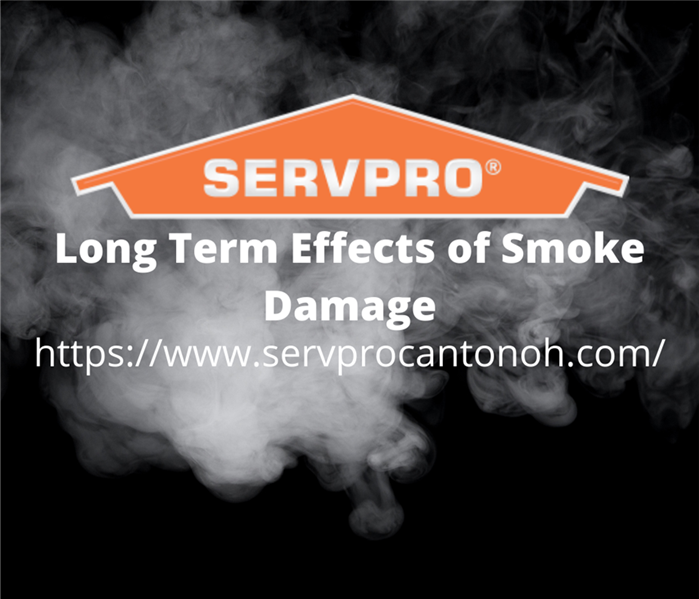 Prevent the damage to your health from smoke and fire damage.
Prevent the damage to your health from smoke and fire damage.
Fires can happen just about anywhere. When they do strike, there can be unfortunate consequences if they are not properly cleaned up after. Many places will have smoke damage left behind, which requires a professional to properly handle. Fires leave behind microscopic particles, which can lead to a variety of health issues.
The health concern that will most likely happen first is the irritation of your eyes and nose. The particles will cause discomfort to your skin. Eyes often become itchy from smoke damage because the particles left behind are irritating to your body. Similarly, you may also get a runny nose because that is a natural way for your body to attempt to keep out the particles left behind from a fire.
Smoke damage can also cause chronic conditions, such as heart and lung issues. The particles from the fire will build up inside of your body. Breathing in harmful substances will have an impact on the health of your lungs since that is where the air you breathe is filtered. The particles can also increase the side effects of other preexisting conditions because your breathing may be worsened from the particles left behind from smoke damage.
The best way to prevent any health issues from occurring from smoke damage is to have the damaged items properly removed. To ensure that your safety is being put first, contact SERVPRO for fast and safe removal. Remember, if you are experiencing any health issues after a fire, contact a doctor immediately.
Tips for Removing Smoke Odor from a Home
1/4/2021 (Permalink)
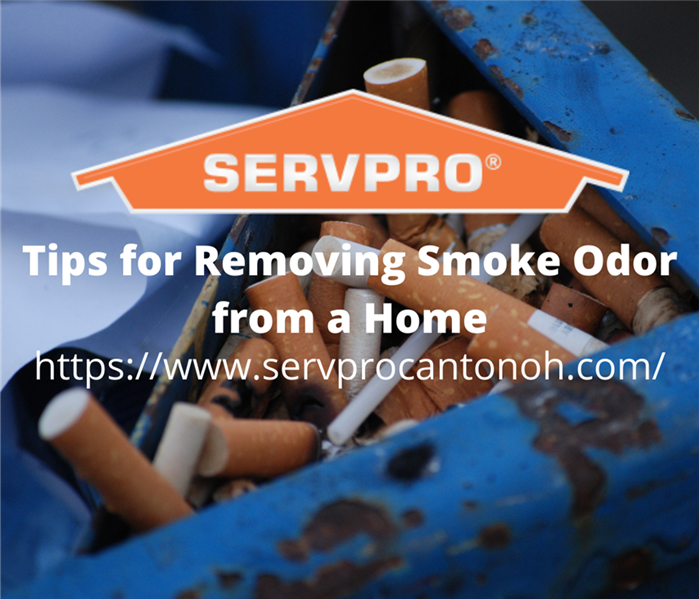 Follow this guide to eliminate the odor from smoke in your home.
Follow this guide to eliminate the odor from smoke in your home.
The smell of smoke is a nuisance, but how does one remove it? To assist in the elimination of smoke odor from home, follow these tips:
Clean out ashtrays
Remove the source. Clean out the ashtrays and ensure that all cigarettes have been put out properly to prevent any fire hazards.
Open windows
Fresh air will help dissipate any smoke smells. Fresh air in and the odorous air out.
Baking soda
Baking soda is one of the best at-home cleaning methods and it can be used for the purpose of removing the odor of smoke. Baking soda will neutralize the odor. This method is best for carpets and fabric surfaces. Sprinkle some on and leave for a day to be vacuumed up. You can also place bowls of baking soda around the home to help remove more of the odor.
Wash fabric items
Take a chance to wash all fabric items; blankets, curtains, pillow covers, clothes, etc. Allow the items to dry outdoors so they don’t reabsorb the smoke odor.
Vinegar
Like baking soda, vinegar removes odor naturally. Wipe down hard surfaces, floors, walls, etc, with white vinegar. And once again, like baking soda, place bowls of vinegar around the home to eliminate the odor.
Ammonia
Ammonia is what to use on the spots that no matter how hard you scrub, the smell still won’t come out! Mixing one cup ammonia with four liters of water, and SCRUB. The smell of ammonia will dissipate in a few days.
Air purifying plants
Some plants are fragrant and can help mask the odor in a home, and some can help filter the smell altogether! Plants such as English ivy, snake plants, spider plants, aloe vera, and the Chinese evergreen will assist in removing toxins and odors from the home.
The Difference Between Laser and Sensor Smoke Detectors
12/2/2020 (Permalink)
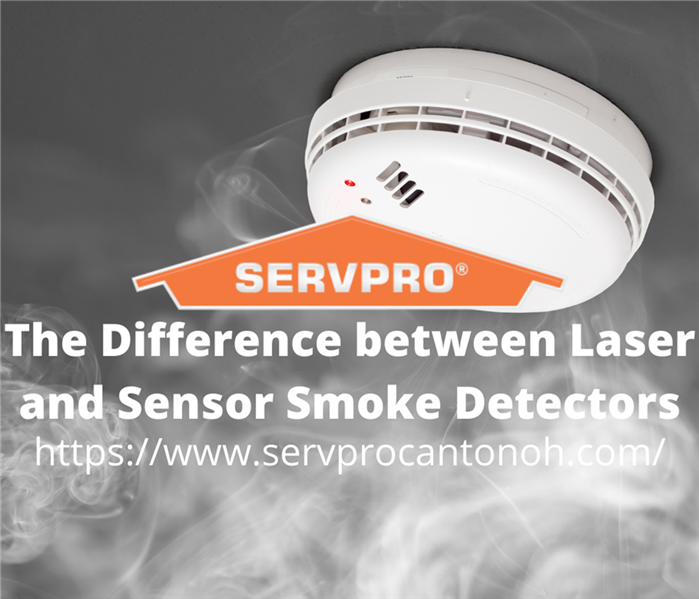 Know the difference between these two smoke detectors to determine which one is best for your home or business.
Know the difference between these two smoke detectors to determine which one is best for your home or business.
Every so often, maybe once a year, you start hearing an annoying beep, every couple of minutes. It takes a few minutes to find the source, but once you do it becomes the first time you’ve thought about your smoke detector all year. Even then you just change the batteries and let it fall from your mind again. Smoke detectors are in place to save your life, so it's important to know you have the right one in your home.
There are two types of detectors: Ionization and Photoelectric, also known as sensor and laser detectors. Almost every home today is equipped with ionization detectors, but more and more people have been making the switch or addition of photoelectric. There are even states such as Iowa, Minnesota, Massachusetts, and Vermont that require the photoelectric system.
What’s the Difference?
Ionization Smoke Detector - An ionization smoke detector contains a small bit of radioactive material that sits between two plates with electrical charges; the charge ionizes the air and causes a current to move between the plates. If smoke enters this chamber, the ion flow is disrupted and the alarm sounds. Ionization smoke detectors are well equipped to sense the very small smoke particles produced by fast-moving, flaming fires.
Photoelectric Smoke Detector - This device aims a focused light source into a sensor chamber; when smoke enters the chamber, it reflects light, which then triggers the alarm. Photoelectric smoke detectors are best at detecting large smoke particles from slow, smoldering fires.
One of the major problems with Ionization sensors is false alarms. How many times have you been cooking dinner and the smoke detector goes off? It is common to just disconnect the battery and forget about it. In fact, recent statistics show that in 24% of home fire deaths, smoke alarms were present but did not sound; in half of those cases, there was a missing or disconnected battery.
Photoelectric detectors are best for responding to a slow-burning, smoldering fire and decrease the chances of safely getting out. These fires usually burn for a period without flames and most often start from a candle of cigarette flame. Ionization detectors take up to 10 minutes longer to detect these fires.
Ionization detectors respond faster to smoke from flaming fires than a photoelectric device does. Most flaming, fast-moving fires are a result of flammable liquids, wood, or paper catching fire. These are items that produce flames right away and do not have as much smoke as a smoldering fire. For this reason, photoelectric devices will provide family members with less advance warning to get to safety before hot, flame-intense fires engulf the residence.
The best way to keep your family safe is to have a blend of photoelectric and ionization smoke detectors. It’s too risky to go with one and not the other because there is no way to predict what type of fire threat your home may experience. Keep photoelectric in the bathrooms and kitchen areas to avoid false alarms. There are also dual sensors available that utilize both ionization and photoelectric technologies. Look into the options available to keep your home a safe haven.
Preventing Kitchen Fires at Your Holiday Dinner
11/18/2020 (Permalink)
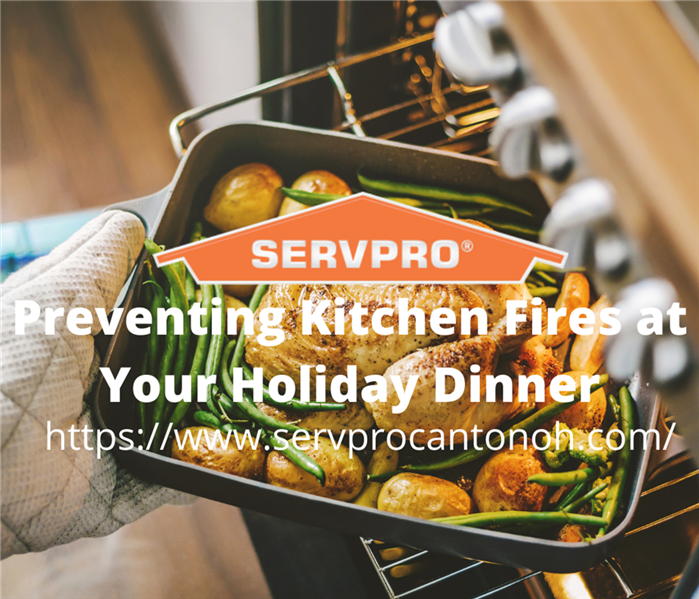 Cook safely this year and prevent common kitchen fires.
Cook safely this year and prevent common kitchen fires.
The vast majority of house fires are most likely to start right in one of the most common areas of your home; that’s right your very own kitchen. For this reason, it is important to exercise extreme caution while cooking, especially during the holiday season with all of your guests around. Luckily, there are several preventative measures you can take to ensure that you, your family, and your food stay safe this holiday season.
Stay Alert
Negligence is the biggest contributor to these fires. Make sure when you have something on the stove or in the oven that you are paying close attention to the temperature and time. Stovetop burners pose an extreme danger in the kitchen when left unsupervised. Additionally, food left in the oven for too long is a recipe for explosion. If you have consumed any alcohol or are feeling tired, it’s probably best for you to stay out of the kitchen.
Keep Your Preparation Area Clear
Ensuring there are no towels, potholders, packaging, or utensils near the stove is a key component to maintaining kitchen safety; this is especially important if the whole family is cooking their multiple dishes at the same time. Decluttering the counter and stovetops will make food preparation easier and safer.
Beware of Crockpots and Other Appliances
Leaving those smaller appliances plugged in at high temperatures for too long poses a risk for electrical fires. Make sure you keep these kinds of appliances on low heat and keep your eye on them throughout the day.
What to do if a Fire Breaks Out in the Kitchen
Remain calm. Calmly instruct your guests to evacuate the house if you recognize the fire is uncontrollable. Should you decide to contain the fire yourself, ensure you still have a plan to get out. Keep a lid by the pans in case of a grease fire to smother the flames. In the case of an oven fire, turn off the heat and keep the door closed until the fire is out. Unplug any electrical appliances that catch fire and use baking soda to extinguish small flames.
Remember SERVPRO is always here for your fire damage needs should an accident ever happen. Stay safe and have a happy holiday!
Keep Your Home Safe: Look for These Common Fire Hazards Around the House
11/4/2020 (Permalink)
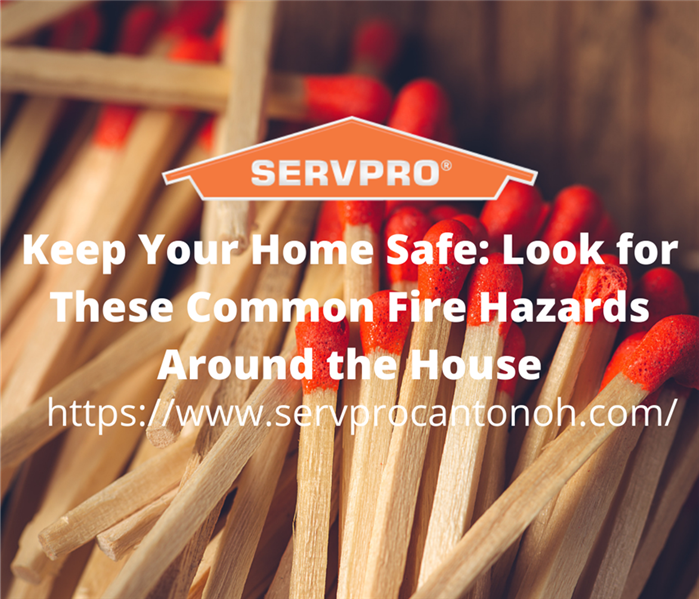 Your home could be at risk for fire damage; be proactive and prevent common housefires.
Your home could be at risk for fire damage; be proactive and prevent common housefires.
Your home should be the safest place possible, especially if you have a big family. Fire hazards can pose a huge danger to the structure of your home and the safety of those living in your household. A house fire can spread rapidly, and burn an entire home down in a matter of minutes. Watch out for these common fire hazards you may not be aware of and keep your home free from the risk of fires year-round.
Unattended Candles
Candles are a major culprit of a number of house fires around the world. Leaving your candles lit when you leave the house or go to bed is leaving your drapery or other surrounding fabrics at risk for catching fire. Always remember to blow all of your candles out if you are not going to be around to attend to them.
Heat Sources
Devices such as space heaters and radiators need to be closely monitored as they can easily get caught on blankets, drapes, and clothing. Remember to never depend on a space heater to heat your entire home and find other solutions that will be safer and long-lasting. Using your oven as a heater is also a big no-no in terms of fire safety, especially a gas stove; this poses a risk to a kitchen fire or even an explosion in your own home. Turn off your portable heaters before leaving the house or going to bed.
Dryers
One of the most silent and undetectable sources of house fires is right inside your laundry room. That’s right; if you neglect to clean your dryer lint repository regularly, it can easily catch fire and create a huge blaze in your home. Remind yourself to clean the lint trap daily and ensure the exhaust vent is clear of any lint as well.
Smoking
This is one of the leading causes of fire deaths in the nation. Smoking in the house is a danger in itself; falling asleep with a lit cigarette is all it would take to start a fire. It’s important to take the smoking outside and always ensure the butts are fully extinguished and placed in an ashtray before entering the home. Children should never be left unsupervised with lighters and matches within their reach.
Keep all of this in mind as you perform your daily household duties. Performing these small preventative measures will benefit the safety of your entire household in the long run. SERVPRO is always here for your fire damage needs should accidents arise.
Preventing Electrical Fires in Your Canton Home
9/24/2020 (Permalink)
 Take care to make sure that electrical fires don't happen in your home.
Take care to make sure that electrical fires don't happen in your home.
As a homeowner, there are many maintenance items on your checklist each year, electrical safety being among the most important. Electrical fires are one of the most common causes of household fires, but they can be easily prevented through proper maintenance and awareness.
There are different ways to avoid electrical fires that almost anyone can follow. The first way is by checking electrical outlets within the household. Improperly installed electrical outlets are one of the top causes of electrical fires. Check for any loose plates or broken wall plates because this ensures that the wiring and components are not left uncovered. As an added safety measure, if children are present within a household, be sure to cover up any unused outlets.
Another way to avoid electrical fires is by checking the plugs within a household. Be sure to never force a plug into an outlet. When plugging in a three pin plug into a two pronged outlet, never remove the third pin from the plug. Instead, use an adapter for a three pin to two prong outlet, it’ll save some time & money and more importantly keep you safe. Be sure to never overload an outlet with too many plugs and adapters because it can cause the outlet to short circuit and start a fire.
An additional safety measure is making sure to check the cords within the household. Check to make sure that each cord isn’t frayed, cracked, under a carpet, or areas where there’s high foot traffic. Never staple cords to walls, floors, and other objects because it can cause the above mentioned issues with the cords. If cords are damaged or frayed, be sure to replace them immediately.
Once you have assessed your household with these ways in mind, be sure to fix any issues upon encountering them. A safe household is a happy household. And of course, be sure to call SERVPRO in the event of a disaster. SERVPRO can handle fire damage restoration making it appear "Like it never even happened."
Emergency Planning Could Save Your Family
7/7/2020 (Permalink)
 Make sure your family knows what to do in the event of a disaster.
Make sure your family knows what to do in the event of a disaster.
You wake up in the middle of the night and you smell smoke. Something is burning in your home and you have to get out. Do you know what you’ll do in the event of this worst-case scenario? If you don’t, then it’s probably a good idea that you sit down and make an emergency plan for your family.
There are many resources on the internet that will provide you with the tools to get started in your emergency planning. Ready.gov suggests asking yourself these questions:
- How will I receive emergency alerts and warnings?
- What is my shelter plan?
- What is my evacuation route?
- What is my family/household communication plan?
- Do I need to update my emergency preparedness kit?
They also provide an emergency plan that you can fill out or simply reference to create your own. This guide will help you make sure you don’t leave any important pieces out of your own plan that you may not have considered if you have never been in an emergency situation before.
Once you have an idea of how you will handle each of the above tasks, as a family you can begin to put together your emergency preparedness kit. The American Red Cross has a list on their website that you can follow as you compile things. You should always start by looking around the house for things you already have before you run to the store to purchase supplies. Chances are you might have quite a few things you need on hand. If you don’t want to spend the time hunting down all the supplies for your kit, however, there are places that you can purchase pre-made kits. Just make sure that you consider the specific needs of your household and add the items that you think you might need that have been left out.
After your plan has been made and your emergency kit is put together, the most important thing you can do with your family is practice. You want to make sure that everyone knows exactly what to do when the time comes to act. In the heat of the moment, some people might panic and forget what to do, but the more you practice the plan, the more likely everyone is to remember. Emergency planning is about ensuring everyone’s safety and there is no better way to do that than to take the time to make sure everyone understands.
Of course, we all hope that we’ll never have to use our emergency plans but it’s better to have one and never need it than to need one that you never made. And if disaster comes knocking at your door, know that SERVPRO of Canton will be right behind it ready to clean up the mess. We will come to your aid 24/7/365 with our highly trained team or disaster restoration specialists and make it "Like it never even happened." Give us a call when a disaster happens and you’ll be back to normal in no time.
Know The Facts About Chimneys To Prevent Fires in Canton Ohio
2/1/2020 (Permalink)
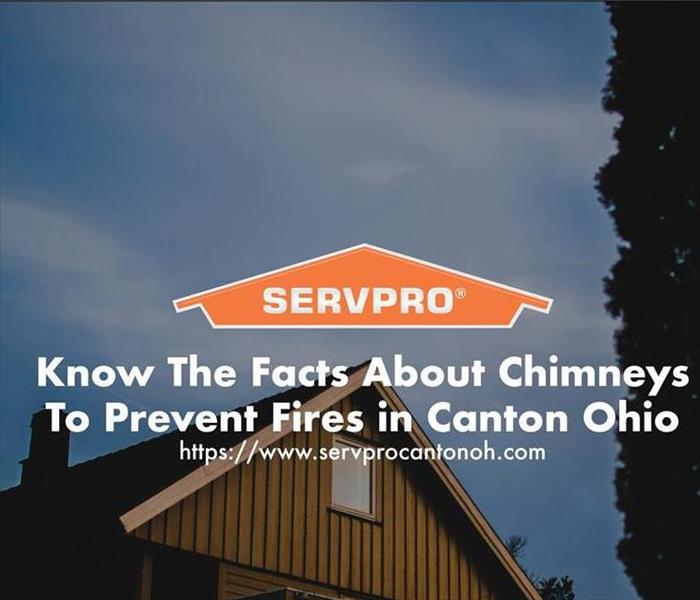 The Majority of Chimney Fires Go Undetected, that is simply because Slow-burning chimney fires don’t get enough air or have fuel to be dramatic.
The Majority of Chimney Fires Go Undetected, that is simply because Slow-burning chimney fires don’t get enough air or have fuel to be dramatic.
Your chimney has architectural interest to your home, but the truth is it is a real function is to carry dangerous flue gases from your fireplace out of your home.
The last thing you are likely to be thinking about is the condition of your chimney. Dirty chimneys can cause chimney fires, which damage structures, destroy homes and injure or kill people. Sometimes fires happen in chimneys and people do not even realize it is happening until it is too late.
Chimney fires can burn explosively; they are noisy and dramatic enough to be detected by neighbors. Flames or dense smoke are signs that you might have a chimney fire. It has been report that these fires sound like a startled low rumbling sound which reminds them of a freight train or a low flying airplane.
Here are 7 ways to prevent a chimney fire:
- Have Your Chimney and Fireplace Cleaned and Inspected Annually
- Build Small Fires
- Use Seasoned Wood
- Never Use Paper or Combustible Liquids in the Fireplace
- Use a Chimney Liner
- Install a Chimney Cap
- Ensure Good Air Supply
The Majority of Chimney Fires Go Undetected, that is simply because Slow-burning chimney fires don’t get enough air or have fuel to be dramatic or visible. They often go undetected until a later chimney inspection is done. The temperatures they reach are very high and can cause as much damage to the chimney structure, which can be too late to fix. It is best to follow the simple tips above in order to prevent a chimney fire at all costs.
Remember, a quick response time can reduce the overall costs and loss of use. We are ready when you need us at SERVPRO of Canton. Call anytime: (330) 305-2650 anytime of the day, someone is waiting to discuss your unique situation and help you determine the best course of action.
How To Reduce Fire In Winter Months
1/4/2020 (Permalink)
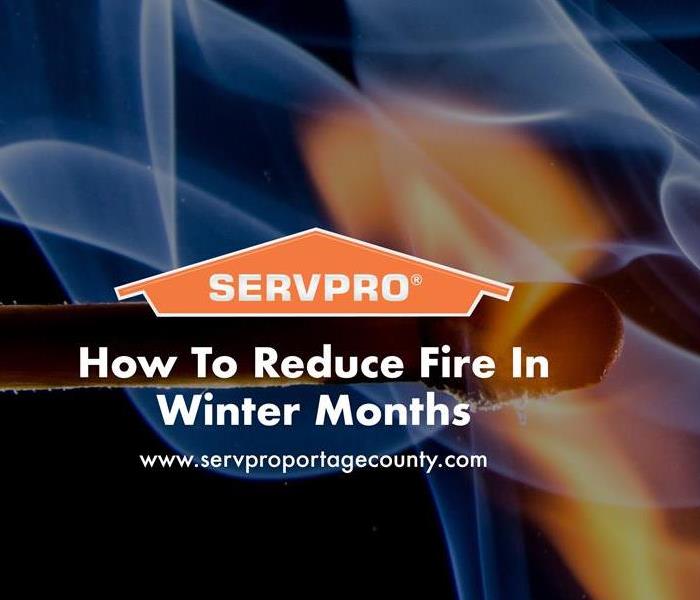 We know how devastating a fire disaster can be, but we are here to help!
We know how devastating a fire disaster can be, but we are here to help!
Most of us spend our time cozied up inside throughout winter! We run our homes on overdrive during cold weather. The National Fire Protection Association (NFPA) claims there are more than 360,000 home structure fires each year, resulting in about $6-8 billion dollars in damage.
Some causes of home fires happen because of the following:
1. Cooking: The U.S. Fire Administration identifies cooking as the leading cause of house fires.
- Never leave the kitchen or appliances unattended while cooking.
- Keep paper products such as towels and potholders away from the stove.
- Keep children and pets three feet away from the stove.
2. Candles: Fires happen a lot because of candles.
- Be sure to extinguish all candles before heading to bed at night.
- Never leave candles unattended.
- Candles should be placed at a minimum of three feet from combustible materials such as decorations, curtains, blankets, etc.
3. Smoking: The warmth of your home may be tempting to smoke indoors if you are a smoker.
- Always use a deep ashtray to put out smoking materials.
- Never discard your cigarette in plants, peat moss, mulch or anything else that can ignite easily.
- Before you toss butts and ashes, ensure they are completely out.
4. Dryers & Washing Machines: There are nearly 3,000 dryer fires reported each year.
- Clean lint filters every time you use the dryer.
- Make sure your dryer vent and ductwork are professionally cleaned once a year.
- Make sure someone is home and awake while the cycle is going.
We know how devastating a fire disaster can be, but we are here to help! Call SERVPRO of Portage County (330) 677-4483 to help get your home restored efficiently.
How to Reduce the Risk of Commercial Kitchen Fires
1/3/2020 (Permalink)
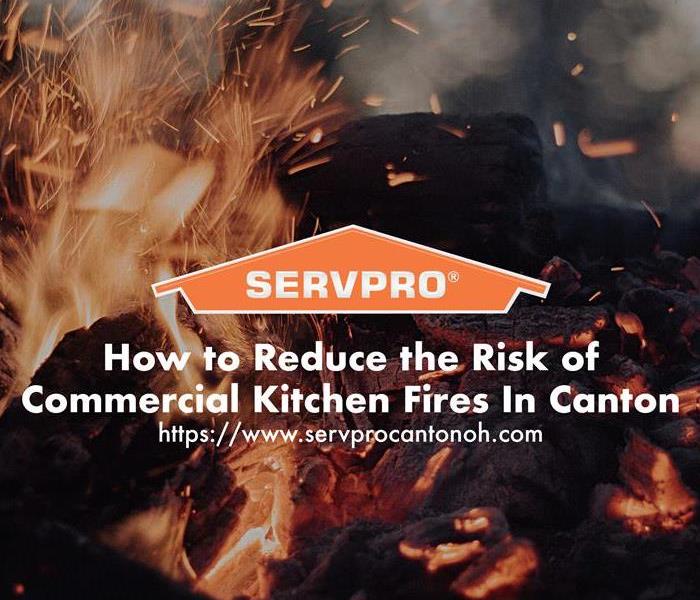 If you or someone you know is faced with fire and needs restoration, the experts at SERVPRO can help
If you or someone you know is faced with fire and needs restoration, the experts at SERVPRO can help
Did you know that commercial kitchens are at high risk for fire? This is because multiple ignition sources and flammable items squeeze into compact: open flames, electrical connections, heating systems, cooking oils and fuels, and so much more.
Prevent fires whenever possible because these events devastate businesses. Typical losses per fire average $23,000 and nearly half of all establishments shut their doors permanently. It is hard to deal with anyway you look at it.
Here are some tips to prevent fires in buildings:
Plan Smartly: Commercial kitchens require fire safety measures that are specific and require regular inspections. These are specified by government codes, ordinances and regulations. It is best to hire experts to assess your fire risks whenever possible.
Maintain Continuously: Kitchen requires regular maintenance to boost fire safety. Make sure to have your appliances, electrical equipment, Class K portable fire extinguishers, exhaust fans and vents must be inspected, refurbished cleaned regularly. It is important to pay attention to where grease traps can happen.
Train Adequately: The most important thing to plan for is to make sure your business develops, distributes and knows the emergency and evacuation plans. Your employees should have knowledge on the kitchen best practices and fire safety measures.
If you or someone you know is faced with fire and needs restoration, the experts at SERVPRO can help to mitigate the damage and restore your home! Call (330) 305-2650
How to Keep Warm and Prevent Space Heater Fires
12/1/2019 (Permalink)
 During the winter months low temperatures happen in Canton Ohio.50% of home heating fires occur during the months of December, January, and February.
During the winter months low temperatures happen in Canton Ohio.50% of home heating fires occur during the months of December, January, and February.
During the winter months low temperatures happen in Canton Ohio. We see many owners turning to alternative sources of heat. 50% of home heating fires occur during the months of December, January, and February. Space heaters are best used with caution.
Follow these safety tips to keep warm with space heaters during the winter months and prevent fire damage:
- When purchasing a space heater, look for a safety certification: Underwriters Laboratories (UL).
- Auto shut off features are beneficial. This will help prevent overheating and hazards.
- Maintain at least three feet of space around the space heater.
- Remove flammable materials such as curtains, bedding, and clothing from being too close to the space heater.
- Keep the heating unit away from water. Keep space heaters away from bathrooms and kitchens.
- Never use an extension cord with space heaters. The amount of power drawn from these units is too much for a low amp extension cord to handle; by doing this it will cause the cord to overheat and spark a fire.
- Plug only the space heater into the wall outlet.
- Keep the space heater on the floor; make sure the floor is either wood or tile.
- Make sure to turn off the heating unit when you leave a room.
- Make sure you have working smoke detectors on every level of the building
If you or someone you know is faced with fire damage and needs restoration, the experts at SERVPRO can help to mitigate the damage and restore your home! Call (330) 305-2650
Avoid a fire tragedy this holiday season in Canton
11/1/2019 (Permalink)
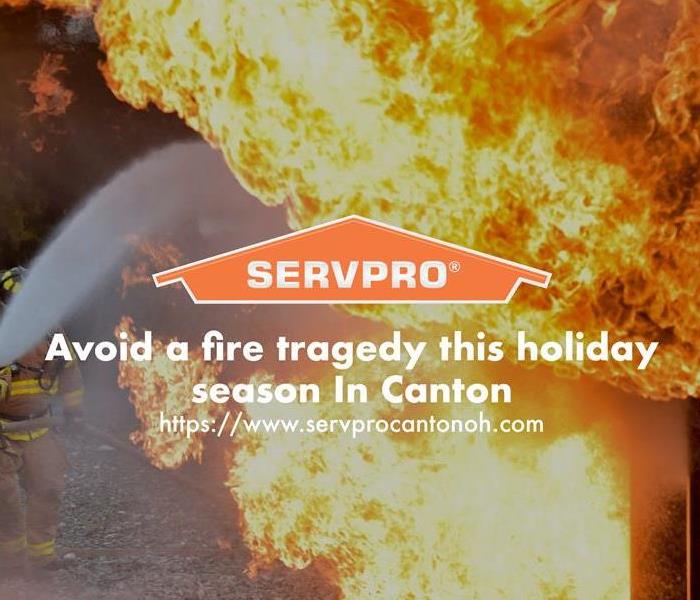 Tragic Christmas tree-related fires can be rare, but according to the National Fire Protection Association, they are much deadly than any other fires
Tragic Christmas tree-related fires can be rare, but according to the National Fire Protection Association, they are much deadly than any other fires
Tragic Christmas tree-related fires can be rare, but according to the National Fire Protection Association, they are much deadly than any other fires. Trees only catch fire when set alight by a blaze that already exists in the home.
Minimizing the chances of a Christmas tree-related fire is possible with the following tips:
- Pick a fresh-looking tree: Fresh trees aren’t as likely to catch fire, according to the American Christmas Tree Association. It’s essential to choose a tree with green needles. Brownish needles mean the tree is really dry, which makes it more flammable. Also, signs of a fresh tree include soft and flexible needles that don’t easily fall off.
- Keep the tree watered: Constant moisture is key, because a dried-out Christmas tree in a home is not good. Experts recommend keeping a real tree watered at all times to ensure that it remains consistently moist.
- Keep tree away from heat: Ensure that the tree is at least 3 feet way from any heat source, such as fireplaces, radiators or heat vents, the NFPA recommends.
- Shake the tree: Give your real tree a good shake. If you find that a lot of needles fall to the ground, it’s a sign that the tree isn’t getting enough water. This is a red flag of danger for fires.
- Check the tree’s lights: Faulty lights can cause a tree to ignite. It’s essential to check the lights you use to decorate the tree.
Christmas trees are met to be fun and jolly, but don’t get caught up in a horrible disaster if you can prevent. These tips and more can help you so that you don’t end up with a fire around the holiday season.
If you are in need of restoration after this disaster give SERVPRO of Canton a call (330) 966-2377. We are open 24 hours 7 days a week.
What If a Fire Strikes in Canton?
9/24/2019 (Permalink)
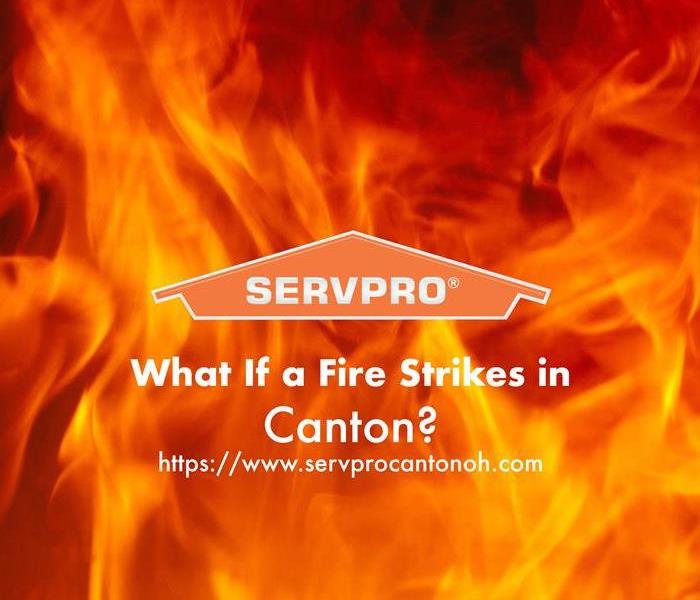 Does your home or business have fire damage ? Call SERVPRO of Canton's 24/7 Emergency Service line at 330-966-2377.
Does your home or business have fire damage ? Call SERVPRO of Canton's 24/7 Emergency Service line at 330-966-2377.
A fire can happen at anytime. Being prepared will help reduce its devastating effects. The first few minutes following a fire are the most significant. If you do not act quickly, there can be consequences; the correct response to a fire can keep effects minimal.
When a fire occurs, notify the fire department, the police department, and the insurance company. Next, call a disaster restoration company, such as SERVPRO of Canton, to help prevent further damage.
By evaluating the materials and surfaces affected, a disaster restoration company will provide an understanding of the fire's chemistry and allow for a targeted, informed restoration effort. Even though each fire's chemistry differs, one of the most important things disaster restoration companies do immediately is wipe down the affected areas to avoid further damage caused by humidity and acidic residues. They will use air scrubbers, which are highly filtered air machines, so soot particles will not recontaminate air and will limit redistribution of contaminated particles while restoration work continues. They will pull all filters from the HVAC system, clean and recondition the system, and then install new filters.
A fire is usually a complex fire, the result of incomplete combustion and fueled by synthetic materials, including those found in carpets, furniture, plumbing, and other equipment. Complex fires cause the most damage and leave the most waste, but disaster restoration professionals can professionally handle the cleanup and restoration.
Does your home or business have fire damage ? Call SERVPRO of Canton's 24/7 Emergency Service line at 330-966-2377.
Top Three Tips for Fire Safety in Canton, Ohio
6/18/2019 (Permalink)
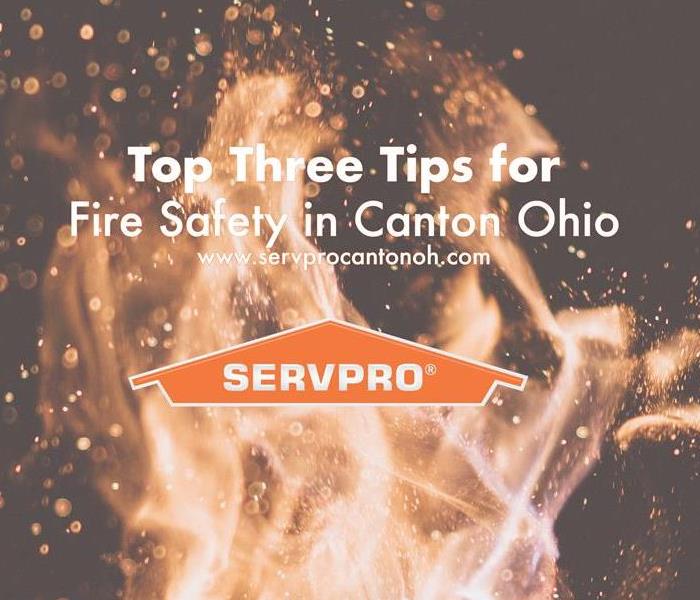 For any fire damage repair or restoration needs, call SERVPRO of Canton at (330) 305-2650.
For any fire damage repair or restoration needs, call SERVPRO of Canton at (330) 305-2650.
Fires escalate quickly and you do not have time to think. Having an escape route practiced (committing it to muscle memory) and working smoke alarms can be literal life savers. What else can you do for fire safety in your home?
Here are our top three tips for fire safety that can keep you and your loved ones as protected as possible.
- Every level of your home should have a smoke alarm installed. Place them inside bedrooms and outside sleeping areas, including the basement, in living rooms and/or near stairways for optimal use.
- Test and maintain smoke alarms regularly. Each month, you should check that they are in proper working condition. If they need new batteries, change them right away. Smoke detectors are critical components to alerting you in time to get out before a fire spreads too much.
- Twice a year, you should practice your fire escape plan with your family. Feel free to talk and plan the route together more than twice a year. However, at least two times every year will ensure it stays fresh in your mind if ever you should need to implement the steps.
Remember to never go back inside for anything at all. If you experience a fire in your home, GET OUT, STAY OUT, and CALL FOR HELP.
For any fire damage repair or restoration needs, call SERVPRO of Canton at (330) 305-2650.
Helping Property Owners Recover from a Fire-Damage Emergency
4/11/2019 (Permalink)
Dealing with a fire-damage emergency and the claims process is an emotionally trying time for a policyholder. A restoration professional must be sensitive to the personal and emotional aspects of a fire-damage situation. It’s imperative to recognize that a homeowner goes through five stages of grief: denial, anger, bargaining, depression and acceptance.
The professional must be prepared to respond appropriately to each situation. Insurance professionals need to prepare the homeowner for the restoration process, work closely with the restoration professional to ensure quality and timely work, and maintain a constant flow of communication throughout the process. A restoration professional must recognize that every loss is significant to the people impacted by it, and take the proper steps to restore the home to preloss condition.
Dealing With a Fire-Damage Emergency
A fire loss is often more severe than a water loss, and special attention to safety is imperative. The restoration professional needs to ask the property owner some simple questions to quickly evaluate the level of damage: “Is there any structural damage? Is there a lot of smoke?”
Air quality is the most important factor to evaluate. With any fire, carcinogens enter the air, and safeguards will need to be put in place to help ensure the safety of the air that the residents and workers breathe. All necessary PPE should be available for technicians, as well as the proper equipment to replace the bad air with fresh air as soon as possible.
If not already aware, the service professional should consider the ages and health of everyone in the home. Young children, the elderly and pregnant women might need to leave the property immediately, as they are often more susceptible to air-quality related health issues. If the client is not comfortable living in the home, the agent needs to assist in finding alternative accommodations for the residents.
Specifics to Consider When Scoping a Smoke and Soot Loss
There are several important steps to take when analyzing a fire-damage emergency:
- Evaluate how much heat was involved that resulted in damage to the structure, fixtures and contents. Look for a “heat line” on the wall, which often indicates possible damage to the structural integrity of the drywall materials.
- Where did the smoke/soot travel to? Did the smoke get into the HVAC system? Did the smoke travel into the attic areas, or force its way into the crawl space or basement?
- Consider pre-cleaning as an alternative process to save the metal and glass items in a home.
- Is there excessive smoke inside of the walls? This often requires removal of the drywall to get rid of the smoke/soot and accompanying odors.
- Determine which systems are available that will best deodorize the property and contents. These include professional cleaning and sanitizing; organic deodorizing systems; hydroxyls; and/or ozone.
- Determine the extent of the damage and the processes/procedures that will return the property, and the lives of those people involved, back to a “preloss” condition as quickly as possible.
- Respond as rapidly as possible to minimize the long-term effects of smoke and soot damage, and the many acids those materials contain.
Smoke and soot-related emergencies require specific mitigation strategies, depending on the materials affected: flat or glossy paint, finished and unfinished; laminates and solid wood items; particle-board materials; natural and man-made fibers in carpets and upholstered furniture. Porous, semi-porous and non-porous materials all require unique cleaning and deodorizing systems to most effectively deal with smoke/soot damage.
Wildfires often destroy thousands of acres of property and hundreds of homes. There is not much a mitigation company can do in those situations. However, there are often thousands of homes that are downwind from the fire that suffer smoke and soot damage, both on the exterior and the interior of homes. Smoke enters around doors and windows, through the ventilation system and even through the soffit vents into the attic areas.
Knowing how to deal with these materials quickly and professionally to neutralize and remove the compounds from the home, and to control and manage the odor damage are key aspects of a professional restoration/mitigation company.
Overall, the most important thing to understand about a fire damage emergency is that helping a client cope with the property loss is first priority. Communication along the way and hand-holding through the process is just as important, if not more, than the property owner receiving a check for the loss.
The restoration professional should be empathetic and emphasize that the damage will be taken care of, but never pass off the restoration process as a casual routine. The level of damage should be evaluated quickly and efficiently. It is critical to work with the insurance agent to educate the policyholder, ease their concerns, and manage their expectations.
Understand that each client will go through five steps of grief, and anticipate that anger will turn up one way or another. If the restoration professional expects this emotion to surface, they will be prepared to help the client cope and restore their sense of calm.
Ask Annissa: How Do I Handle Sensitive Documents Damaged in a Fire Loss?
4/2/2019 (Permalink)
Personal papers like bills, canceled checks, credit card statements and everyday magazines have no value in the eyes of the insurance company and they often don’t want to pay for them to be cleaned or deodorized. However, they often have value to the homeowner.
The biggest problem with this is that paper can hold a lot of odor and may re-contaminate the house once everything is unpacked. So first off, we check with the homeowner and see if the paperwork is something that they can live without. Or is it really important and needs to be kept? Once you explain that the papers can hold a lot of odor and may cause recontamination of the house and belongings, this will sometimes make the homeowner more aggressive about putting them in the round file.
If the paperwork cannot be parted with and must go on the “keep it list,” then we dust them off and organize them into a large 11x14 inch spec bag. This is a heavy duty plastic bag that keeps the odor and contamination contained until the homeowner can photo copy or reprint the documents they want to keep. The cost to the insurance company to handle them this way is really no more than their cost would be to throw them away, so this keeps your adjuster and homeowner happy.
This also allows the homeowner to go through the papers at their convenience as they are dealing with a lot of pressing decisions in the first few days after a fire. Having one less pressing thing to have to handle right away can be a huge relief for them.
NEVER...Walk Away From Your Stove!
1/11/2019 (Permalink)
Sporting Events and Television!
It happens, especially during sporting events…… you can hear the roar of excitement from the other room, and you know you are missing the big play of the game. So you leave the stove, just for a quick peek. Only it’s just never as quick as you anticipate. Meanwhile back in the kitchen….grease fire has erupted. It can happen so quickly, the cooking oil gets over heated and out of control.
Good Rule: never leave the stove or turn your back for any period of time.
Think fast!
1) Evaluate – call 911 if it is out of control while gathering family and get to safety
2) Put a metal lid on it
3) Turn off the heat
4) Dump baking soda
5) Chemical fire extinguisher is best as a last resort or if the above options are not available
6) Stop. Let the area sit, cool down, before you address the damage.
NO, NO, NO
1) Do not throw water
2) Do not use a hand towel
We hope you never need to remember these tips. But your SERVPRO Team is here to help with the clean up should disaster strike. The photos are from a kitchen grease fire; just a second of “unattended”. The good news is the final repairs are beautiful; "Like it never even happened." No family members, or pets were injured in the event. Just frayed nerves and a bit of quilt. (Accidents happen and we should learn from them and move forward.)
Quick thinking allowed the structure damage to be contained to the kitchen. However soot and smoke damage occurred throughout the residence.
We are here to help 800-648-1212
10 tips to prevent chimney fires
11/3/2018 (Permalink)
Proper home maintenance requires constant vigilance.
Chimneys, in particular, require upkeep. A chimney that is dirty, blocked or in disrepair can inhibit proper venting of smoke up the flue, and can also cause a chimney fire. Nearly all residential fires originating in the chimney are preventable, according to the New York State Homeland Security and Emergency Services.
Chimney fires account for 75% of home heating fires, meaning homeowners should actively monitor their chimneys. Homeowners looking to avoid damage to their property and increased premiums should prepare for fires by checking their smoke alarms and updating their emergency plan.
The Chimney Safety Institute of America recommends looking for these signs of a pending chimney fire: a loud cracking and popping noise; a lot of dense smoke; or an intense, hot smell.
Ask Annissa: How Do I Handle Sensitive Documents Damaged in a Fire Loss?
9/10/2018 (Permalink)
What’s the best way to handle and clean personal papers in a fire loss that have been damaged by soot and also smell? The homeowner wants to keep them and won’t let me throw them away.
Personal papers like bills, canceled checks, credit card statements and everyday magazines have no value in the eyes of the insurance company and they often don’t want to pay for them to be cleaned or deodorized. However, they often have value to the homeowner.
The biggest problem with this is that paper can hold a lot of odor and may re-contaminate the house once everything is unpacked. So first off, we check with the homeowner and see if the paperwork is something that they can live without. Or is it really important and needs to be kept? Once you explain that the papers can hold a lot of odor and may cause recontamination of the house and belongings, this will sometimes make the homeowner more aggressive about putting them in the round file.
If the paperwork cannot be parted with and must go on the “keep it list,” then we dust them off and organize them into a large 11x14 inch spec bag. This is a heavy duty plastic bag that keeps the odor and contamination contained until the homeowner can photo copy or reprint the documents they want to keep. The cost to the insurance company to handle them this way is really no more than their cost would be to throw them away, so this keeps your adjuster and homeowner happy.
This also allows the homeowner to go through the papers at their convenience as they are dealing with a lot of pressing decisions in the first few days after a fire. Having one less pressing thing to have to handle right away can be a huge relief for them.
The Anatomy of a Fire: Understanding 3 Types of Fires & Effective Cleaning Techniques
9/5/2018 (Permalink)
According to the National Fire Protection Association, it’s estimated that some 370,000 home fires occur each year, costing close to $7 billion in total property damage. In many of these home fires, however, the fire starts and is contained in a certain area of a home or business. Even though containment eliminates the necessity for complete demolition and reconstruction, it is still necessary for proper cleaning of soot and smoke to commence, in order to restore the property to a preloss condition. Anatomy of a FireContrary to what many may believe, there is more than one type of fire — and the type of fire that occurred will dictate the appropriate cleaning method. The most prevalent types of fires are: high-oxygen fires, which produce dry soot; low-oxygen fires, which produce greasy, wet soot, and kitchen fires. Here’s a closer look at how to clean each type of fire:
- High oxygen: Dry sponges are a must. Follow this by applying a low-alkali detergent and then rinse thoroughly.
- Low oxygen: Use high-alkali detergents along with warm water to wash the walls and structures. Rinse, then paint over.
- Kitchen: These are often the most challenging fires to clean, as soot residue is difficult to detect. For this reason, cabinets, drawers and other appliances often need to be removed to adequately clean the area.
General Cleaning TechniquesSmoke and soot can penetrate paint, carpet, upholstery and clothes. While carpet can be deep cleaned and clothes can be taken to the dry cleaner, properly restoring walls, structures and objects is a different story. Here’s a look at some general cleaning techniques:- Personal protective equipment: Gloves, a protective mask, long-sleeved shirts and pants should be worn on site to minimize contact with ash.
- Remove contents: Remove contents from the house. While some contents may have to be discarded, others can be effectively hand cleaned. Cleaning contents in an ultrasonic machine is also an option with some items.
- Ventilate: Open windows and doors to remove odor.
- Beware of other contaminants: Lead and asbestos can turn a fire restoration job into an environmental restoration job if they’ve become disturbed.
- Hand scrubbing: Fire damage work is one of the most tedious types of repair work. It involves a lot of handwork, such as scrubbing walls and structures with sponges — and using chemicals and specialized restoration equipment, such as media blasting tools, in the event of heavy residue.
- Duct cleaning: Following restoration, a duct cleaning is required. That’s because smoke and soot have a tendency to become trapped within a home or business’s duct system. This can spread contaminants — and odors — to other areas of the home when in operation. Hence, a professional duct cleaning is necessary.
Techniques for Various Materials- Clothes and fabrics: A specialized dry cleaner is capable of restoring these items to preloss condition. Cleaning soot-contaminated clothing is somewhat of a science, and while a homeowner may be able to adequately restore clothing on his own, it’s always best to leave this to the professionals.
- Carpet: A professional carpet cleaning is a must in order to effectively remove contaminants and odor from the carpet.
- Building materials: Dry chemical sponges are your best bet for wallboard, plaster, wood and wallpaper. These will remove much of the soot and also prevent it from being lodged deeper into the material.
- Other materials: Sponges, towels and mops are ideal for cleaning tile, glass, metal and certain appliances. Since these aforementioned objects are less porous than drywall, for example, it’s OK to use a wet or dampened sponge or cleaning tool. Plus, there’s no risk of lodging contaminants deeper into the material.
- Specialty cleaning tools: Ultrasonic cleaning machines can come in handy as they can adequately clean non-porous items quickly and efficiently, compared to hand cleaning.
When it comes to a fire damage situation, you also need to remember how vulnerable the homeowner is in the situation. While any type of home catastrophe is never welcome, a fire has the potential to be the most devastating. With that in mind, also be sure to work on your customer service skills, communicate effectively and regularly with the homeowner to determine his needs throughout the process, and keep him up to speed on the project’s progress. Where a water damage situation can be restored in as little as three days, it’s not uncommon for a fire damage situation to last several weeks — or even months if reconstruction is involved. Hence, proper cleaning and handling of a project is all the more important.
Dentist Abandons Practice After Fire Loss- Will Policy Proceeds be Recovered?
5/7/2018 (Permalink)
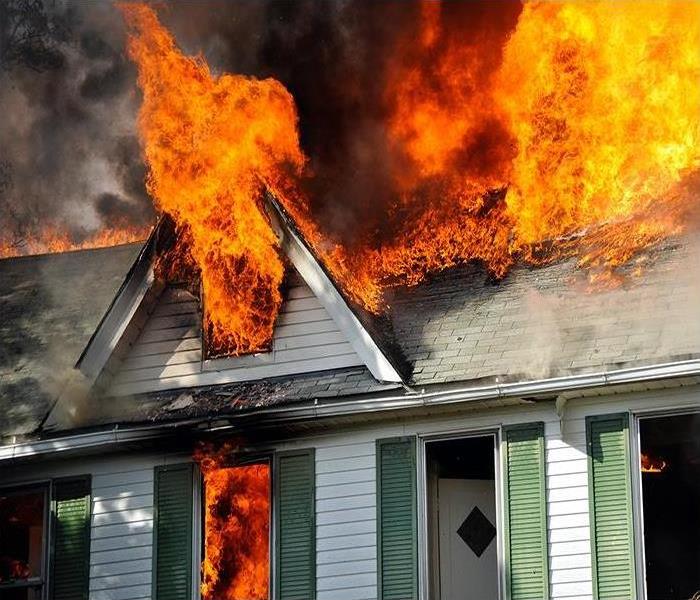 Fire & Smoke Restoration Technician | Odor Control Technician | Upholstery & Fabric Cleaning Technician | Water Damage Restoration Technician
Fire & Smoke Restoration Technician | Odor Control Technician | Upholstery & Fabric Cleaning Technician | Water Damage Restoration Technician
An Excerpt from Property Casualty 360 Q&A
Question: Our insured had total fire loss and is insured under a business-owners policy. The insured is a dentist and determined that as of this loss she would abandon this practice as she had other locations that were more productive.
Since there was a direct loss from a covered peril, but no period of restoration to speak of, will the insured recover any policy proceeds under business income coverage?
Answer: In order for business income coverage to be triggered, the insured must suffer an actual loss of business income due to the necessary suspension of operations during the period of restoration. If the dentist is not continuing the business at that location, and it is not going to be repaired or replaced, you are correct that there is no period of restoration, and there is also no loss of income due to suspension of operations, so there would be no business income coverage.
Fire Damage ? Call SERVPRO of Canton's 24/7 Emergency Service line - 330-966-2377
For information on SERVPRO of Canton fire damage services, click here.
Homeowners policy. Fire coverage. What do I need?
4/4/2018 (Permalink)
In Ohio alone, there were 105 home fire fatalities reported in 2016.
A home fire is reported every 90 seconds in the United States.
One death occurs every 2 hours and 35 minutes, according to the National Fire Protection Association (NFPA).
Now is the time to review your coverage, Northeast Ohio.
But first, consider the five most common causes of house fires:
- Cooking equipment is the number one source of home fires and the second leading cause of home fire deaths – usually leaving pots or pans unattended on the stove while you run away to do something for “just a minute.” The NFPA says that 47% of all house fires start this way.
- Heating equipment accounts for 15% of home fires, specifically this time of year. Trying to heat the home with space heaters or chimneys that aren't properly cleaned are the leading causes of heating equipment fires.
- Electrical distribution and lighting equipment account for approximately 9% of home fires, and can come from a number of different origins. They can be caused by an equipment malfunction, from an overloaded circuit or extension cord, or from an overheated light bulb, space heater, washer, dryer or other appliance.
- Intentional fires account for approximately 8% of home fires. The majority of these fires are started outside but still average $1 billion in direct property damage.
- Smoking materials are on a downward trend, however, they still account for 5% of home fires and are the leading cause of home fire deaths.
Other common causes include candles, children playing with fire, and Christmas trees.
*Stay tuned for our next blog post covering House Fire Safety Tips for each "cause of fire" listed above.
Taking precaution will reduce the risk of a fire starting in your home, but the bottom line is you need to make sure you have enough coverage in the event of a major fire loss.
Fire insurance is a necessary part of your homeowners policy. If you have a comprehensive homeowners policy, fire coverage will be included. However, there are many different providers and policies, therefore a variety of coverage limits, deductibles and exclusions defining what is, and is not, covered.
If your property is insured for actual cash value, your fire coverage may be less than what is needed to replace your damaged structures and items.
You can, and should, very seriously consider insuring your property with replacement value coverage instead. This type of coverage will cover the cost of rebuilding a house similar to your previous one after a fire, and provides funds to replace damaged appliances, clothing, and furniture with new items.
KNOW WHAT YOU OWN. We highly recommend you do a video recording of your full house and document your contents.
Your homeowners policy provides the following coverage options to protect your home from fire (check your policy to make sure you understand any exclusions):
- Covers the structure of your home
- Covers additional structures on your property, including sheds, garages and outbuildings
- Insures the contents, or your personal belongings, in each of the structures, including furniture, appliances, electronics, clothes, etc.
- Provides for living expenses if a fire displaces you and your family for a period of time, including rent or hotel expenses
Choosing the right insurance company is incredibly important, but even more important is selecting the best insurance agency to service your needs, and educating yourself on what you are buying.
Does your home have fire damage ? Call SERVPRO of Canton for help - 330-966-2377 or Request Help Online.
Renters Insurance and a Squirrel On Fire- What You Need to Know
1/11/2018 (Permalink)
 Blow torch the fur, they said. It'll be great, they said. One massive fire later... Better call SERVPRO.
Blow torch the fur, they said. It'll be great, they said. One massive fire later... Better call SERVPRO.
It's been proven, Canton, that using a blowtorch to remove the fur of a squirrel is not an intelligent thing to do. Renter's insurance, however, is absolutely an intelligent thing to do, especially if you insist on using a blowtorch on your rented property to remove the fur of a squirrel rather than use a knife to skin the thing.
$300k renters insurance settlement proves you shouldn’t blowtorch a squirrel, a piece written by Marc Christopherson and published on LiveInsuranceNews.com, tells its readers the crime, the consequences and the solution of blow torching a squirrel on rental premises and setting afire multiple units of the apartment complex. What I want our readers to pay attention to is the insurance company's role in this situation and understand the impact of having renters insurance.
To keep it simple, they believed the blow torch would remove the fur from the squirrel so they could eat it as their main course meal. They did not intend to light on fire their apartment unit as well as those around theirs, but that is precisely what happened, causing $2 million in damage.
Naturally, the complex owners sued the couple for the damage costs and the case moved its way around the appeals court, never reaching an agreement until about 4 years later.
Finally, in August of 2016, the apartment complex and the tenant's renters insurance company agreed on a settlement of $300,000, which would be paid by the insurance company to the complex owners. That is not exactly the $2 million settlement the complex wanted, but you can't have it all, I guess.
The fact to take away from this story is that without renters insurance, who knows where this couple would be now. $300,000 from their insurance policy compared to $2 million from who knows where, having their renters insurance, an annual or monthly price that is very affordable, saved their you-know-what's in the end.
But, seriously, blow torching a squirrel ? Kids, don't try this at home. Actually, I take that back- kids and adults, don't try this ever.
For more information on this story, follow this link.
Do you have fire damage to your home or business ? No matter the cause, squirrel or oven grease, we will help. Call us today at 330-966-2377, or request help online.
Include Safety in Your Thanksgiving Holiday
11/15/2017 (Permalink)
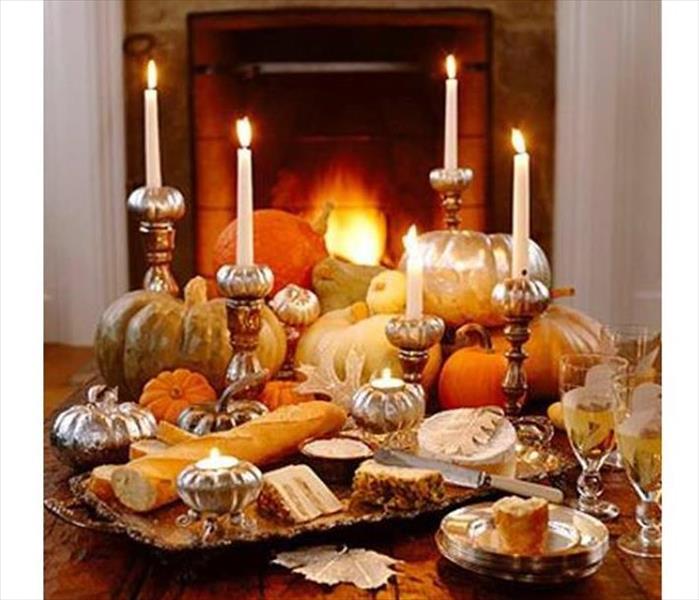 Candles cause an estimated 15,600 house fires, 150 deaths, and 1,270 injuries each year. Never leave a candle unattended.
Candles cause an estimated 15,600 house fires, 150 deaths, and 1,270 injuries each year. Never leave a candle unattended.
Especially during the holidays, the kitchen is the heart of the home. From baking and decorating cookies to testing family recipes, keeping kitchen fire safety at the top of your mind is a must- certainly when there is a lot of activity and people in one space.
Some Thanksgiving not-so-fun facts:
- Thanksgiving is the peak day for home cooking fires, followed by Christmas Eve/Day.
- In 2015, U.S. fire departments responded to an estimated 1,760 home cooking fires on Thanksgiving.
- Unattended cooking was the leading contributing factor in cooking fires and fire deaths.
With that said, here are some safety tips for the 2017 Thanksgiving holiday:
- Stay in the kitchen/home when you are cooking so you can keep an eye on the food.
- Make sure kids stay away from the stove and oven.
- Keep the floor clear so you don’t trip over kids, toys, pocketbooks or bags.
- Be sure electric cords are not dangling off the counter within easy reach of a child or pet.
- Keep matches and utility lighters out of the reach of children.
- Never leave children alone in room with a lit candle.
- Make sure your smoke alarms are working.
Caution is not a buzz kill. A house fire, on the other hand, is.
Have a happy and safe Thanksgiving holiday, Canton, OH!
Why a Fire Restoration Contractor is the Way to Go
10/20/2017 (Permalink)
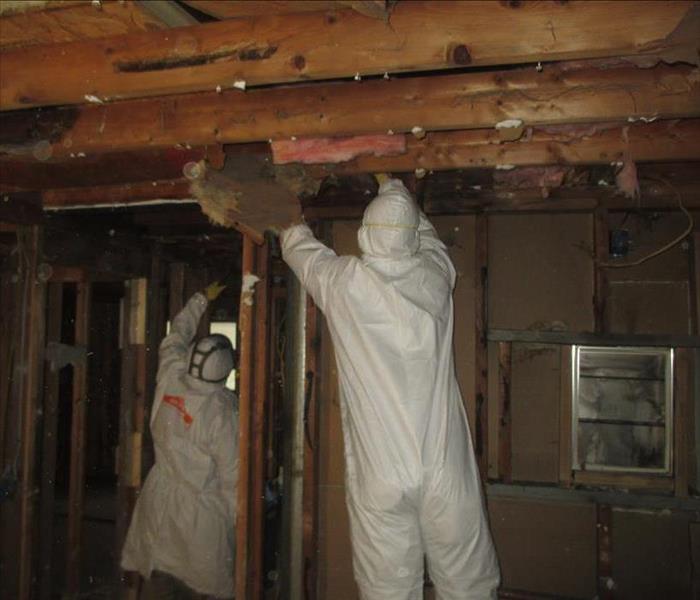 When fire & water damage strikes, a fast response is critical. We’re dedicated to responding immediately, day or night, to your Summit County property
When fire & water damage strikes, a fast response is critical. We’re dedicated to responding immediately, day or night, to your Summit County property
A fire restoration contractor can help you restore your home properly after a house fire.
When you hire a fire restoration company, it dispatches several fire restoration contractors, each of whom has the knowledge to use the tools necessary to complete the job. Their skills vary, from reducing the dangers in your home after a fire to preventing secondary water damage. Hiring a fire restoration contractor is an excellent idea because it allows the experts to work on many different things at once, which lets you focus on other things like insurance matters.
A Fire Restoration Contractor’s Equipment
A fire restoration contractor has a variety of tools and the knowledge necessary to use them effectively. One example of this is an ozonation machine. This machine generates ozone, a toxic gas, which fills the house and can partially reverse the effects of smoke odor from embedding itself in everything. These machines are expensive and dangerous, and only a qualified professional should use them.
Getting a referral from your insurance provider is an excellent idea. This ensures that the company you hire has contractors that actively implement sound business practices and can restore your home properly and in accordance with any applicable laws. In addition to this, this method allows you to be sure that the contracting company and your insurance provider can work well together and agree on an appropriate settlement.
Have Questions about Fire, Smoke, or Soot Damage?
Call Us Today – 330-650-4486
Fire Safety: Unplug Household Appliances
9/14/2017 (Permalink)
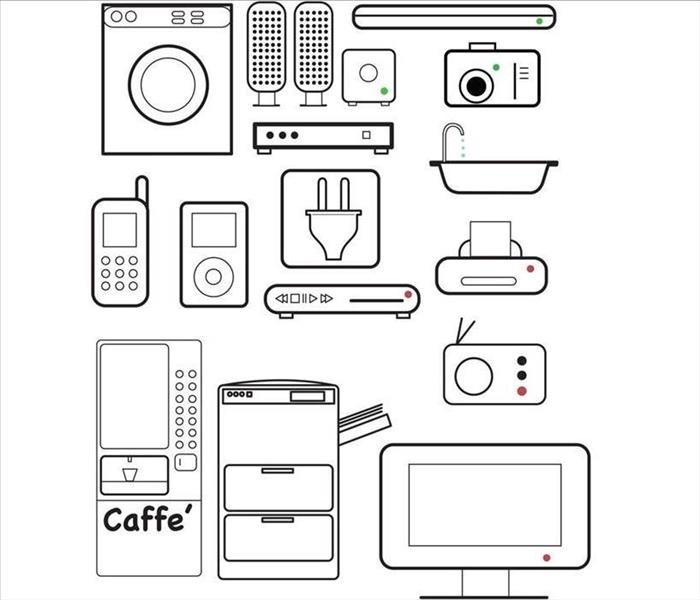 The consumption of household appliances worldwide is forecast to generate nearly 590 billion U.S. dollars in revenues by 2020.
The consumption of household appliances worldwide is forecast to generate nearly 590 billion U.S. dollars in revenues by 2020.
With electric appliances being so common in modern homes, it's easy to forget that there are very real risks and hazards associated with their use and even non-use.
Being safe when using electrical appliances, extension cords, light bulbs and other equipment is easy. It only takes one mistake to spark an electrical fire, but simple prevention measures can be effective solutions.
These safety tips can help keep all appliances operating safely and help you prevent unexpected fires in the home:
- Ensure any appliances you purchase are approved by Underwriters Laboratories (UL) or another reputable consumer laboratory.
- Unplug unused appliances and store cords safely out of reach of pets, young children or hazardous situations.
- Appliances that generate heat, such as clocks, televisions and computer monitors, should be given several inches of clearance all around for good air circulation and cooling.
- Do not attempt amateur repairs or upgrades.
- Keep all electric appliances away from water such as sinks, bathtubs, pools or overhead vents that may drip.
- Do not operate any electrical appliance with wet hands or while standing in water.
- Keep clothes, curtains toys and other potentially combustible materials away from radiators, space heaters, heating vents and other heat sources.
Source: Stephanie Sage of Sage Restoration
To read more on this subject, click here.
Have Questions about Fire Safety? Do you have fire damage? Call Us Today – (330) 966-2377
Why a Fire Restoration Contractor is the Way to Go
9/6/2017 (Permalink)
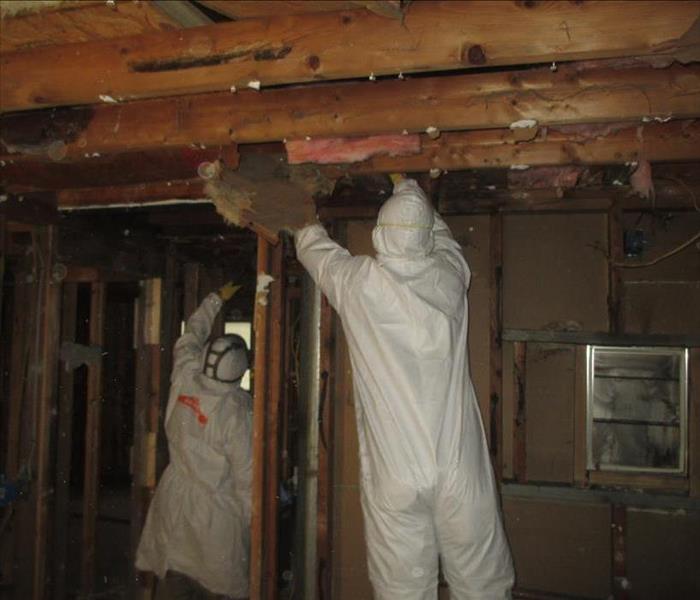 Our “restore first” mentality gets you back into your home or business quicker and with less disruption to your life.
Our “restore first” mentality gets you back into your home or business quicker and with less disruption to your life.
A fire restoration contractor can help you restore your home properly after a house fire.
When you hire a fire restoration company, it dispatches several fire restoration contractors, each of whom has the knowledge to use the tools necessary to complete the job. Their skills vary, from reducing the dangers in your home after a fire to preventing secondary water damage. Hiring a fire restoration contractor is an excellent idea because it allows the experts to work on many different things at once, which lets you focus on other things like insurance matters.
A Fire Restoration Contractor’s Equipment
A fire restoration contractor has a variety of tools and the knowledge necessary to use them effectively. One example of this is an ozonation machine. This machine generates ozone, a toxic gas, which fills the house and can partially reverse the effects of smoke odor from embedding itself in everything. These machines are expensive and dangerous, and only a qualified professional should use them.
Getting a referral from your insurance provider is an excellent idea. This ensures that the company you hire has contractors that actively implement sound business practices and can restore your home properly and in accordance with any applicable laws. In addition to this, this method allows you to be sure that the contracting company and your insurance provider can work well together and agree on an appropriate settlement.
Have Questions about Fire, Smoke, or Soot Damage?
Call Us Today – 330-966-2377
Fire Damage Cleanup
8/28/2017 (Permalink)
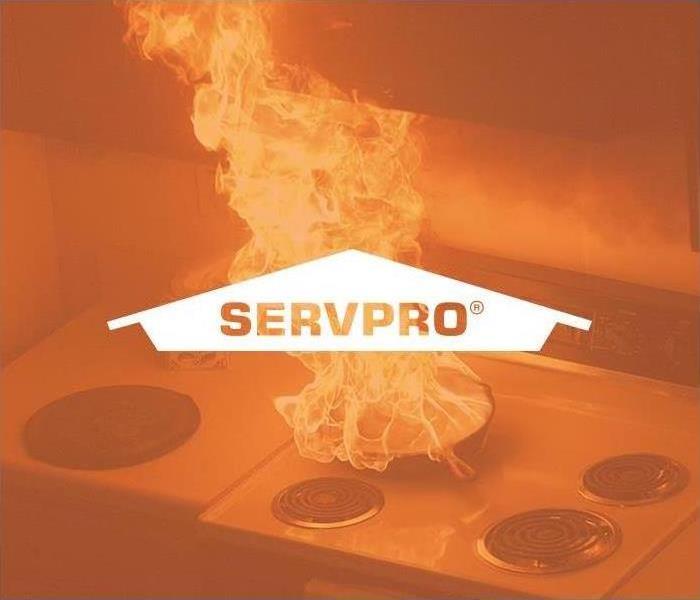 We have the knowledge and the specialized equipment to get your property back to pre-fire condition.
We have the knowledge and the specialized equipment to get your property back to pre-fire condition.
Fire damage clean up is an arduous process that often requires the proper industrial equipment and time. A standard vacuum cleaner is rarely enough. In addition, time is of the essence. In the wake of a fire, when victims are faced with insurance matters, arrangements for interim housing, and possible health concerns, homeowners are unlikely to make salvage efforts the top priority. Sadly, this could present a costly dilemma. In these cases, the services of a certified fire restoration company are invaluable.
The Institute of Inspection, Cleaning and Restoration Certification (IICRC) states that delays in fire damage clean up can have serious consequences. In addition to the obvious devastation created by heat, flames, and soot, water and smoke are powerful contaminators and destructors in their own right. Immediate intervention is critical to minimize exposure to these damaging agents in hopes of limiting restoration costs.
In addition to the structural destruction caused by the flames, acidic soot alone can cause irreparable harm to a home’s interior and belongings. But the problems don’t end there. Odor removal can present another challenge, and ceiling or box fans alone are not always powerful enough to disperse the smell of smoke. Water damage caused by first responders in an effort to extinguish the inferno further complicates matters.
For more information on fire cleanup and how to choose a restoration firm to do the damage cleanup, visit the IICRC website.
Do you need fire damage cleanup? Call our 24/7 Emergency Service line at (330) 966-2377, or request online help.
How to Keep Safe During a House Fire
8/17/2017 (Permalink)
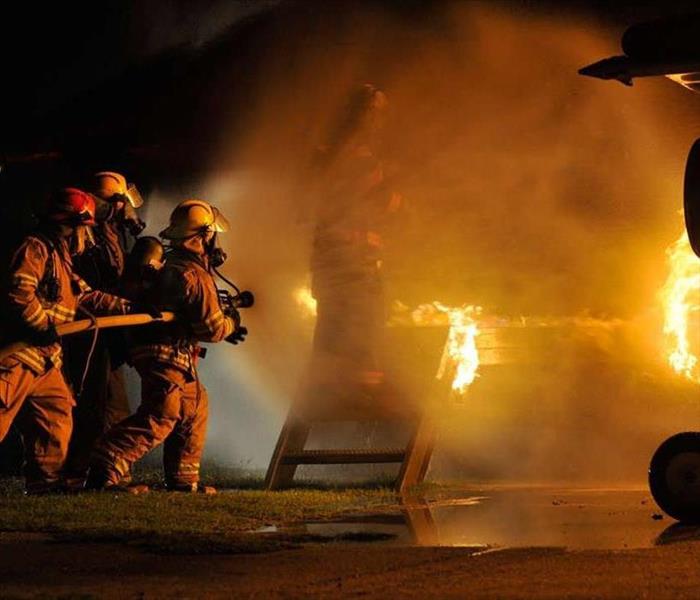 In less than 30 seconds a small flame can turn into a major fire. It takes minutes for smoke to fill a house or for it to be engulfed in flames.
In less than 30 seconds a small flame can turn into a major fire. It takes minutes for smoke to fill a house or for it to be engulfed in flames.
You may not think you'll ever fall victim to a house fire, but it's better to be prepared and know what to do to avoid panicking if it happens to you. To increase your chances of survival, follow these steps:
Keeping safe in your house during a fire:
- React as soon as you hear your smoke alarm go off. If you hear your smoke detector or see fire, exit your home as safely as possible. Do not stop to grab your belongings. Your only concern should be to get out as quickly as possible.
- Safely exit through doors. If you see smoke under the door, do not open the door to escape. If you do not see smoke, put the back of your hand to the door to feel for heat. If it is cool, open slowly and pass through. If you see fire, close the door to protect yourself from the fire and search for another exit.
- Prevent yourself from smoke inhalation. Get low to the floor and crouch or crawl on your hands and knees to evade the toxic smoke, avoiding disorientation and unconsciousness. If you must walk through the smoke, cover your nose and mouth with a shirt or towel.
- Stop drop and roll if your clothes catch fire. Immediately stop what you're doing, drop flat on to the ground and roll around until you smother the fire. Cover your face with your hands as you're rolling to protect yourself.
- Ward off the smoke if you can't get out. If you cannot escape, you can always reclaim some measure of control and stay safe, even if you feel trapped. Close the door and cover all vents and cracks with a cloth or tape to keep the smoke out.
- Call for help from a second story window. If you are trapped in a second story room, do what you can to get yourself to an area where people will be able to hear or see you. Take a sheet- preferably white- and hang it out the window to signify you need help. Be sure to close the window to the fresh oxygen doesn't draw the fire towards you. Put a blanket or towel at the base of the door to prevent the smoke from coming underneath.
- Escape from a second story window if you can. If you have an escape ladder, toss it down the side of the house. If you must go out the window, look for a ledge you can get yourself onto and hang down from your hands, facing the side of the building. Let yourself fall to safety.
What to do once you exit your home:
- Do a head count. Make sure everyone is accounted for. If anybody is missing, only re-enter the building if it is safe to do so. Tell the first responders immediately on their arrival if you are afraid someone is missing.
- Call 911. Use your cellphone or call from a neighbor's house.
- Do an injury assessment. After making the call and the resources are coming, check yourself and your family for any injuries. If there are, do what you can to address them until the fire department arrives.
- Get away from the structure. Keep a safe distance between you and the fire.
Preventing future house fires:
- Form and practice your family's escape plan. Have a plan of escape in the event of a fire. Practice at least twice a year to get comfortable with the routine. Plan to find two ways to escape from each room. Practice escaping by crawling, being in the dark and having your eyes closed.
- Make sure your home is prepared. Check your smoke detectors are working and always have fresh batteries. Make sure your windows can easily be opened and that screens can be quickly removed. Everyone in your family should be able to open and close all windows. Buy reliable collapsible ladders in case of higher level escapes.
- Practice safe behaviors. Teach your children that fire is a tool, not a toy. Always be in the kitchen when you're cooking. SO not smoke in the house and make sure you put out your cigarettes entirely. DIspose of any electronics with frayed wires. Avoid lighting candles unless they're directly in your line of vision. Always check that the gas is turned off as well as any other wired electronics. Finally, try to use a lighter instead of matchsticks.
For more information as well as a community Q&A, click here for the source of the above information.
Canton, Ohio Smoke and Soot Cleanup
12/1/2016 (Permalink)
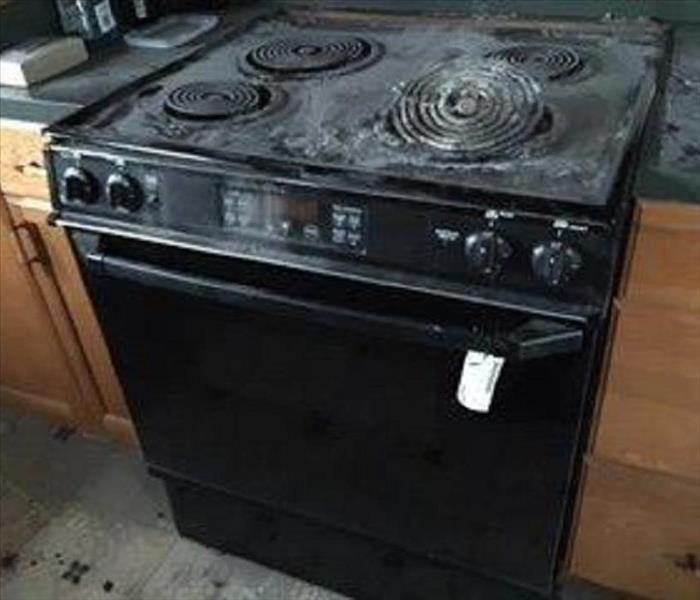 Smoke and Soot Damage Can Cause a Pervasive Odor in Your Canton, Ohio Home.
Smoke and Soot Damage Can Cause a Pervasive Odor in Your Canton, Ohio Home.
Smoke and soot is very invasive and can penetrate various cavities within your home, causing hidden damage and odor. Our smoke damage expertise and experience allows us to inspect and accurately assess the extent of the damage to develop a comprehensive plan of action.
Smoke and soot facts:
- Hot smoke migrates to cooler areas and upper levels of a structure.
- Smoke flows around plumbing systems, seeping through the holes used by pipes to go from floor to floor.
- The type of smoke may greatly affect the restoration process.
Different Types of Smoke
There are two different types of smoke–wet and dry. As a result, there are different types of soot residue after a fire. Before restoration begins, SERVPRO of Canton, Ohio will test the soot to determine which type of smoke damage occurred. The cleaning procedures will then be based on the information identified during pretesting. Here is some additional information:
Wet Smoke – Plastic and Rubber
- Low heat, smoldering, pungent odor, sticky, smeary. Smoke webs are more difficult to clean.
Dry Smoke – Paper and Wood
- Fast burning, high temperatures, heat rises therefore smoke rises.
Protein Fire Residue – Produced by evaporation of material rather than from a fire
- Virtually invisible, discolors paints and varnishes, extreme pungent odor.
Our Fire Damage Restoration Services
Since each smoke and fire damage situation is a little different, each one requires a unique solution tailored for the specific conditions. We have the equipment, expertise, and experience to restore your fire and smoke damage. We will also treat your family with empathy and respect and your property with care.
Have Questions about Fire, Smoke, or Soot Damage?
Call Us Today – 330-966-2377
Holiday Fire Safety Tips
12/4/2015 (Permalink)
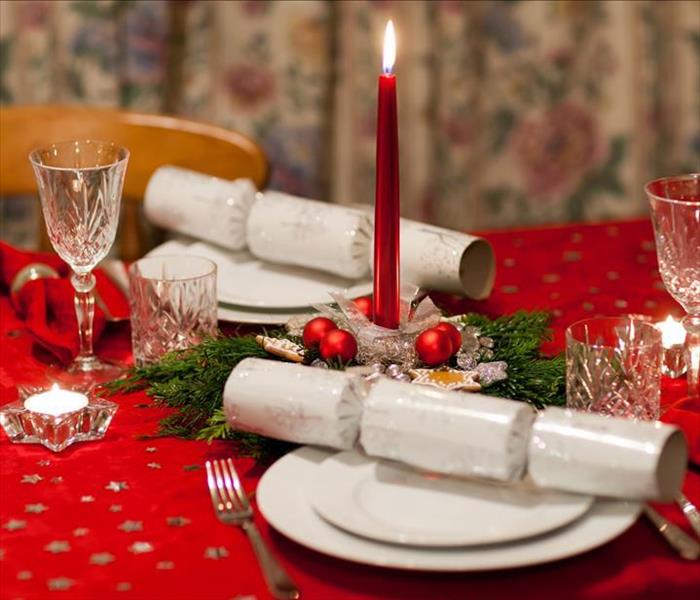 Stay safe this holiday!
Stay safe this holiday!
As the holiday season approaches, so does the peak time of year for cooking and candle fires. Cooking equipment is the number one cause of home and workplace fires. Thanksgiving, Christmas Day, and Christmas Eve are the three peak days for cooking fires. Candle fires peak on Christmas Day, Christmas Eve, and New Year’s Eve. SERVPRO reminds you and your family to stay safe this holiday season by following these fire safety tips:
Cooking Safety Tips
· Be especially careful when frying food. Frying is the greatest fire risk.
· Be aware that electric ranges cause more fires than gas ranges.
· Never leave cooking unattended. Unattended cooking causes 90% of kitchen fires.
· Clean thoroughly to prevent grease buildup.
Candle Safety Tips
· Please candles a safe distance from flammable objects. The leading cause of candle fires is placing candles too close to something that can burn, such as curtains or furniture.
· Do not leave candles unattended.
Smoke Detector Safety Tips
· Test smoke detectors once per month. Having working smoke alarms reduces one's chance of dying by fire by about half.
· Change batteries twice per year.
· Replace smoke detectors every 10 years.
· Be sure you have smoke detectors on each level of the home and placed near or inside each bedroom at a high point in the room.
Fire Extinguisher Safety Tips
· Follow the acronym P.A.S.S. – Pull the pin, Aim at the base, Squeeze the lever, & Sweep from side to side
· The best type of fire extinguisher for home use is a multipurpose "ABC" extinguisher, which uses a dry powder that is able to put out most types of fires.
· Fire extinguishers should be placed in plain sight close to ground level in areas of the home that are more prone to fires, such as the kitchen and garage.
· Keep a fire extinguisher in each occupied bedroom to help you and your family escape if a fire occurs during the night.
· Although fire extinguishers should last for 5-15 years, check the gauge regularly to make sure the needle is in the green area and inspect the pin, hose, and handle periodically.
Sources:
Akron Fire Department General Fire Safety presentation materials
http://www.nfpa.org/safety-information/for-consumers/causes/cooking
http://www.nfpa.org/research/reports-and-statistics/fire-causes/candles
Prevent Christmas Tree Fires This Holiday Season!
12/9/2014 (Permalink)
Christmas tree safety tips
From the National Fire Protection Association: http://www.nfpa.org/ Each year, fire departments respond to an average of 210 structure fires caused by Christmas trees. Carefully decorating Christmas trees can help make your holidays safer.
Picking the tree
- If you have an artificial tree, be sure it is labeled, certified, or identified by the manufacturer as fire retardant.
- Choose a tree with fresh, green needles that do not fall off when touched.
Placing the tree
- Before placing the tree in the stand, cut 1" - 2" from the base of the trunk.
- Make sure the tree is at least three feet away from any heat source, like fireplaces, radiators, candles, heat vents or lights.
- Make sure the tree is not blocking an exit.
- Add water to the tree stand. Be sure to add water daily.
Lighting the tree
- Use lights that have the label of an independent testing laboratory. Some lights are only for indoor or outdoor use, but not both.
- Replace any string of lights with worn or broken cords or loose bulb connections. Connect no more than three strands of mini string sets and a maximum of 50 bulbs for screw-in bulbs. Read manufacturer’s instructions for number of LED strands to connect.
- Never use lit candles to decorate the tree.
- Always turn off Christmas tree lights before leaving home or going to bed.
After Christmas
- Get rid of the tree when it begins dropping needles. Dried-out trees are a fire danger and should not be left in the home or garage, or placed outside against the home. Check with your local community to find a recycling program. Bring outdoor electrical lights inside after the holidays to prevent hazards and make them last longer.
 Smoke contains acidic compounds that can corrode metal, weaken wood, and discolor walls and ceilings, which can compromise the integrity of your home.
Smoke contains acidic compounds that can corrode metal, weaken wood, and discolor walls and ceilings, which can compromise the integrity of your home.






 24/7 Emergency Service
24/7 Emergency Service


